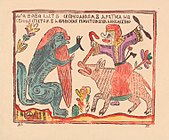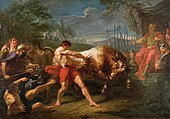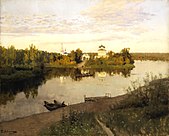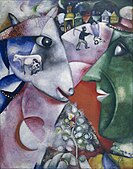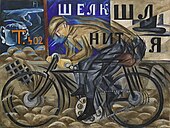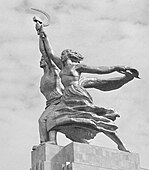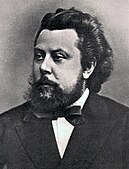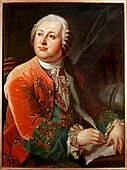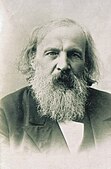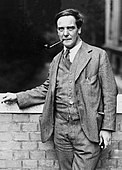Culture of Russia
This articleneeds additional citations forverification.(March 2022) |
This articlecontains too many pictures for its overall length.(February 2024) |
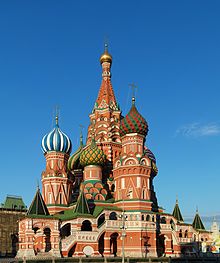
| Part ofa serieson the |
| Culture of Russia |
|---|
 |
| Society |
| Topics |
| Symbols |

Russianculture (Russian:Культура России,romanized:Kul'tura Rossii,IPA:[kʊlʲˈturərɐˈsʲiɪ]) has been formed by the nation's history, its geographical location and its vast expanse, religious and social traditions, and bothEastern[1]andWestern influence.[2]Russianwritersandphilosophershave played an important role in the development of European thought.[3][4]The Russians have also greatly influencedclassical music,[5]ballet,[6]sport,[7]painting,[8]andcinema.[9]The nation has also made pioneering contributions toscience and technologyandspace exploration.[10][11]
History
[edit]Thehistory of Russiabegins with the histories of theEast Slavs.[12][13]The traditional start date of specifically Russian history is the establishment of theRus'state in the north in the year 862, ruled byVarangians.[14][15]In 882, PrinceOleg of NovgorodseizedKiev,uniting the northern and southern lands of the Eastern Slavs under one authority, moving the governance center to Kiev by the end of the 10th century, and maintaining northern and southern parts with significant autonomy from each other. The stateadopted Christianity from the Byzantine Empirein 988, beginning the synthesis ofByzantineandSlaviccultures that definedRussian culturefor the next millennium.Kievan Rus'ultimately disintegrated as a state due to theMongol invasionsin 1237–1240. After the 13th century,Moscowemerged as a significant political and cultural force, driving theunification of Russian territories.By the end of the 15th century, many of thepetty principalitiesaround Moscow had been united with theGrand Duchy of Moscow,which took full control of its own sovereignty underIvan the Great.
Ivan the Terribletransformed the Grand Duchy into theTsardom of Russiain 1547. However, the death of Ivan's sonFeodor Iwithoutissuein 1598 created asuccession crisisand led Russia into a period of chaos and civil war known as theTime of Troubles,ending with the coronation ofMichael Romanovas the first Tsar of theRomanov dynastyin 1613. During the rest of the seventeenth century, Russia completed theexploration and conquest of Siberia,claiming lands as far as the Pacific Ocean by the end of the century. Domestically, Russia faced numerous uprisings of the various ethnic groups under their control, as exemplified by theCossackleaderStenka Razin,who led a revolt in 1670–1671. In 1721, in the wake of theGreat Northern War,TsarPeter the Greatrenamed the state as theRussian Empire;he is also noted for establishingSt. Petersburgas the new capital of his Empire, and for his introducing Western European culture to Russia. In 1762, Russia came under the control ofCatherine the Great,who continued the westernizing policies of Peter the Great, and ushered in the era of theRussian Enlightenment.Catherine's grandson,Alexander I,repulsed aninvasion by the French Emperor Napoleon,leading Russia into the status of one of thegreat powers.
Peasant revolts intensified during the nineteenth century, culminating withAlexander IIabolishingRussian serfdomin 1861. In the following decades, reform efforts such as theStolypin reformsof 1906–1914, theconstitution of 1906,and theState Duma(1906–1917) attempted to open and liberalize the economy and political system, but the emperors refused to relinquishautocratic ruleand resisted sharing their power. A combination of economic breakdown, mismanagement overRussia's involvement in World War I,and discontent with the autocratic system of government triggered theRussian Revolutionin 1917. Theend of the monarchyinitially brought into office a coalition of liberals and moderate socialists, but their failed policies led to theOctober Revolution.In 1922,Soviet Russia,along with theUkrainian SSR,Byelorussian SSR,andTranscaucasian SFSRsigned theTreaty on the Creation of the USSR,officially merging all four republics to form the Soviet Union as a single state. Between 1922 and 1991 the history of Russia essentially became thehistory of the Soviet Union.[opinion]During this period, theSoviet Unionwas one ofthe victorsinWorld War IIafter recovering from asurprise invasion in 1941byNazi Germanyand itscollaborators,which had previously signed anon-aggression pactwith the Soviet Union. The Soviet Union's network ofsatellite statesin Eastern Europe, which were brought into itssphere of influencein the closing stages of World War II, helped the country become asuperpowercompeting with fellow superpower theUnited Statesand other Western countries in theCold War.
By the mid-1980s, with the weaknesses of Soviet economic and political structures becoming acute,Mikhail Gorbachevembarked on major reforms, which eventually led to the weakening of thecommunist partyanddissolution of the Soviet Union,leaving Russia again on its own and marking the start of thehistory of post-Soviet Russia.The Russian Soviet Federative Socialist Republic renamed itself as theRussian Federationand became the primarysuccessor state to the Soviet Union.[16]Russia retained itsnuclear arsenalbut lost itssuperpowerstatus. Scrapping thecentral planningand state-ownership of property of the Soviet era in the 1990s, new leaders, led by PresidentVladimir Putin,took political and economic power after 2000 and engaged in an assertiveforeign policy.Coupled with economic growth, Russia has since regained significant global status as a world power. Russia's 2014annexation of the Crimean Peninsulaled to economic sanctions imposed by the United States and theEuropean Union.Russia's 2022invasion of Ukraineled to significantly expandedsanctions.Under Putin's leadership,corruption in Russiais rated as the worst in Europe, and Russia'shuman rights situationhas been increasingly criticized by international observers.Language and literature
[edit]Russia's 160 ethnic groups speak some 100 languages.[17]According to the 2002 census, 142.6 million people speakRussian,followed byTatarwith 5.3 million andUkrainianwith 1.8 million speakers.[18]Russian is the only official state language, but the Constitution gives the individualrepublicsthe right to make their native language co-official next to Russian.[19]Despite its wide dispersal, the Russian language is homogeneous throughout Russia. Russian is the most geographically widespread language of Eurasia and the most widely spokenSlavic language.[20]Russian belongs to theIndo-European languagefamily and is one of the living members of theEast Slavic languages;the others beingBelarusianandUkrainian(and possiblyRusyn). Written examples ofOld East Slavic(Old Russian) are attested from the 10th century onwards.[21]
Over a quarter of the world's scientific literature is published in Russian. Russian is also applied as a means of coding and storage of universal knowledge—60–70% of all world information is published in the English and Russian languages.[22]The language is one of the sixofficial languagesof theUnited Nations.[citation needed]
Folklore
[edit]Russianfolkloretakes its roots in thepaganbeliefs of ancientSlavs,which is nowadays still represented in theRussian folklore.Epic Russianbylinasare also an important part ofSlavic mythology.The oldest bylinas ofKievancycle were recorded in theRussian North,especially inKarelia,where most of theFinnishnational epicKalevalawas recorded as well.[citation needed]

ManyRussian fairy talesand bylinas were adapted forRussian animations,or for feature movies by famous directors likeAleksandr Ptushko(Ilya Muromets,Sadko) andAleksandr Rou(Morozko,Vasilisa the Beautiful). Some Russian poets, includingPyotr YershovandLeonid Filatov,created a number of well-known poetical interpretations of classical Russian fairy tales, and in some cases, like that ofAlexander Pushkin,also created fully original fairy tale poems that became very popular.[citation needed]
Folklorists today consider the 1920s theSoviet Union's golden age of folklore. The struggling new government, which had to focus its efforts on establishing a new administrative system and building up the nation's backwards economy, could not be bothered with attempting to control literature, so studies of folklore thrived. There were two primary trends of folklore study during the decade: theformalistandFinnishschools. Formalism focused on the artistic form of ancient byliny and faerie tales, specifically their use of distinctive structures and poetic devices.[23]The Finnish school was concerned with connections amongst related legends of various Eastern European regions. Finnish scholars collected comparable tales from multiple locales and analyzed their similarities and differences, hoping to trace these epic stories' migration paths.[24]

OnceJoseph Stalincame to power and put hisfirst five-year planinto motion in 1928, the Soviet government began to criticize and censor folklore studies. Stalin and the Soviet regime repressed folklore, believing that it supported the old tsarist system and a capitalist economy. They saw it as a reminder of the backward Russian society that theBolshevikswere working to surpass.[26]To keep folklore studies in check and prevent "inappropriate" ideas from spreading amongst the masses, the government created the RAPP – theRussian Association of Proletarian Writers.The RAPP specifically focused on censoring fairy tales and children's literature, believing that fantasies and "bourgeois nonsense" harmed the development of upstanding Soviet citizens. Fairy tales were removed from bookshelves and children were encouraged to read books focusing on nature and science.[27]RAPP eventually increased its levels of censorship and became theUnion of Soviet Writersin 1932.[citation needed]
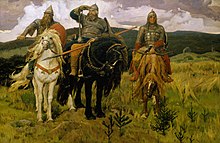
In order to continue researching and analyzing folklore, intellectuals needed to justify its worth to the Communist regime. Otherwise, collections of folklore, along with all other literature deemed useless for the purposes of Stalin's Five Year Plan, would be an unacceptable realm of study. In 1934,Maksim Gorkygave a speech to the Union of Soviet Writers arguing that folklore could, in fact, be consciously used to promote Communist values. Apart from expounding on the artistic value of folklore, he stressed that traditional legends and fairy tales showed ideal, community-oriented characters, which exemplified the model Soviet citizen.[28]Folklore, with many of its conflicts based on the struggles of a labor-oriented lifestyle, was relevant to Communism as it could not have existed without the direct contribution of the working classes.[29]Also, Gorky explained that folklore characters expressed high levels of optimism, and therefore could encourage readers to maintain a positive mindset, especially as their lives changed with the further development of Communism.[24]
Yuri Sokolov,the head of the folklore section of the Union of Soviet Writers also promoted the study of folklore by arguing that folklore had originally been the oral tradition of the working people, and consequently could be used to motivate and inspire collective projects amongst the present-day proletariat.[30]Characters throughout traditional Russian folktales often found themselves on a journey of self-discovery, a process that led them to value themselves not as individuals, but rather as a necessary part of a common whole. The attitudes of such legendary characters paralleled the mindset that the Soviet government wished to instill in its citizens.[31]He also pointed out the existence of many tales that showed members of the working class outsmarting their cruel masters, again working to prove folklore's value to Soviet ideology and the nation's society at large.[32] Convinced by Gorky and Sokolov's arguments, the Soviet government and the Union of Soviet Writers began collecting and evaluating folklore from across the country. The Union handpicked and recorded particular stories that, in their eyes, sufficiently promoted the collectivist spirit and showed the Soviet regime's benefits and progress. It then proceeded to redistribute copies of approved stories throughout the population. Meanwhile, local folklore centers arose in all major cities.[33]Responsible for advocating a sense of Soviet nationalism, these organizations ensured that the media published appropriate versions of Russian folktales in a systematic fashion.[24]
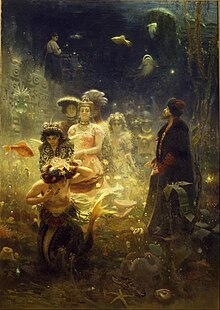
Apart from circulating government-approved fairy tales and byliny that already existed, during Stalin's rule authors parroting appropriate Soviet ideologies wrote Communist folktales and introduced them to the population. These contemporary folktales combined the structures and motifs of the old byliny with contemporary life in the Soviet Union. Called noviny, these new tales were considered therenaissanceof the Russian epic.[34]Folklorists were called upon to teach modern folksingers the conventional style and structure of the traditional byliny. They also explained to the performers the appropriate types of Communist ideology that should be represented in the new stories and songs[35]As the performers of the day were often poorly educated, they needed to obtain a thorough understanding ofMarxistideology before they could be expected to impart folktales to the public in a manner that suited the Soviet government. Besides undergoing extensive education, many folk performers traveled throughout the nation in order to gain insight into the lives of the working class, and thus communicate their stories more effectively.[36]Due to their crucial role in spreading Communist ideals throughout the Soviet Union, eventually some of these performers became highly valued members of Soviet society. A number of them, despite their illiteracy, were even elected as members of the Union of Soviet Writers.[37]
These new Soviet fairy tales and folk songs primarily focused on the contrasts between a miserable life in old tsarist Russia and an improved one under Stalin's leadership.[38]Their characters represented identities for which Soviet citizens should strive, exemplifying the traits of the "New Soviet Man".[39]The heroes of Soviet tales were meant to portray a transformed and improved version of the average citizen, giving the reader a clear goal for an ideal community-oriented self that the future he or she was meant to become. These new folktales replacedmagicwith technology, and supernatural forces with Stalin.[40]Instead of receiving essential advice from a mythical being, the protagonist would be given advice from omniscient Stalin. If the character followed Stalin's divine advice, he could be assured success in all his endeavors and a complete transformation into the "New Soviet Man".[41]The villains of these contemporary fairy tales were theWhitesand their leader Idolisce, "the most monstrous idol", who was the equivalent of the tsar. Descriptions of the Whites in noviny mirrored those of theTartarsin byliny.[42]In these new stories, the Whites were incompetent, stagnant capitalists, while the Soviet citizens became invincible heroes.[43]
Once Stalin died in March 1953, folklorists of the period quickly abandoned the new folktales. Written by individual authors and performers, noviny did not come from the oral traditions of the working class. Consequently, today they are considered pseudo-folklore, rather than genuine Soviet (or Russian) folklore.[44]Without any true connection to the masses, there was no reason noviny should be considered anything other than contemporary literature. Specialists decided that attempts to represent contemporary life through the structure and artistry of the ancient epics could not be considered genuine folklore.[45]Stalin's name has been omitted from the few surviving pseudo-folktales of the period.[44]Instead of considering folklore under Stalin a renaissance of the traditional Russian epic, today it is generally regarded as a period of restraint and falsehood.[citation needed]
Literature
[edit]Russian literatureis considered to be among the world's most influential and developed.[46]It can be traced to theMiddle Ages,when epics and chronicles inOld East Slavicwere composed.[47]By theAge of Enlightenment,literature had grown in importance, with works fromMikhail Lomonosov,Denis Fonvizin,Gavrila Derzhavin,andNikolay Karamzin.[48]From the early 1830s, during theGolden Age of Russian Poetry,literature underwent an astounding golden age in poetry, prose and drama.[49]Romanticismpermitted a flowering of poetic talent:Vasily Zhukovskyand later his protégéAlexander Pushkincame to the fore.[50]Following Pushkin's footsteps, a new generation of poets were born, includingMikhail Lermontov,Nikolay Nekrasov,Aleksey Konstantinovich Tolstoy,Fyodor TyutchevandAfanasy Fet.[48]
The first great Russian novelist wasNikolai Gogol.[51]Then cameIvan Turgenev,who mastered both short stories and novels.[52]Fyodor DostoevskyandLeo Tolstoysoon became internationally renowned.Ivan Goncharovis remembered mainly for his novelOblomov.[53]Mikhail Saltykov-Shchedrinwrote prose satire,[54]whileNikolai Leskovis best remembered for his shorter fiction.[55]In the second half of the centuryAnton Chekhovexcelled in short stories and became a leading dramatist.[56]Other important 19th-century developments included the fabulistIvan Krylov,[57]non-fiction writers such as the criticVissarion Belinsky,[58]and playwrights such asAleksandr GriboyedovandAleksandr Ostrovsky.[59][60]The beginning of the 20th century ranks as theSilver Age of Russian Poetry.This era had poets such asAlexander Blok,Anna Akhmatova,Boris Pasternak,Konstantin Balmont,[61]Marina Tsvetaeva,Vladimir Mayakovsky,andOsip Mandelshtam.It also produced some first-rate novelists and short-story writers, such asAleksandr Kuprin,Nobel Prize winnerIvan Bunin,Leonid Andreyev,Yevgeny Zamyatin,Dmitry MerezhkovskyandAndrei Bely.[48]
After the Russian Revolution of 1917, Russian literature split into Soviet andwhite émigréparts. In the 1930s,Socialist realismbecame the predominant trend in Russia. Its leading figure wasMaxim Gorky,who laid the foundations of this style.[62]Mikhail Bulgakovwas one of the leading writers of the Soviet era.[63]Nikolay Ostrovsky's novelHow the Steel Was Temperedhas been among the most successful works of Russian literature. Influential émigré writers includeVladimir Nabokov,[64]andIsaac Asimov;who was considered one of the "Big Three"science fictionwriters.[65]Some writers dared to oppose Soviet ideology, such as Nobel Prize-winning novelistAleksandr Solzhenitsyn,who wrote about life in the Gulag camps.[66]
Philosophy
[edit]Some Russian writers, likeTolstoyandDostoyevsky,are known also as philosophers, while many more authors are known primarily for their philosophical works.Russian philosophyblossomed since the 19th century, when it was defined initially by the opposition ofWesternizers,advocating Russia's following the Western political and economical models, andSlavophiles,insisting on developing Russia as a unique civilization. The latter group includesNikolai DanilevskyandKonstantin Leontiev,the early founders ofeurasianism.[citation needed]
In its further developments, Russian philosophy was always marked by a deep connection to literature and interest increativity,society, politics and nationalism;cosmosand religion were other primary subjects. Notable philosophers of the late 19th and early 20th centuries includeVladimir Solovyov,Sergei Bulgakov,Pavel Florensky,Nikolai Berdyaev,Vladimir LosskyandVladimir Vernadsky.In the 20th century Russian philosophy became dominated byMarxism.[citation needed]
Humour
[edit]Russia owes much of its wit to the great flexibility and richness of the Russian language, allowing for puns and unexpected associations. As with any other nation, its vast scope ranges from lewd jokes and sillyword playtopolitical satire.[citation needed]
Russian jokes,the most popular form ofRussian humour,are short fictional stories or dialogues with apunch line.Russian joke culture features a series of categories with fixed and highly familiar settings and characters. Surprising effects are achieved by an endless variety of plots. Russians love jokes on topics found everywhere in the world, be it politics, spouse relations, ormothers-in-law.[citation needed]
Chastushka,a type of traditional musicalRussian poetry,is a singlequatrainintrochaictetrameterwith an ABAB or ABCBrhyme scheme.Usuallyhumorous,satirical,or ironic in nature, chastushkas are often put to music as well, usually withbalalaikaoraccordionaccompaniment. The rigid, short structure (and to a lesser degree, the type of humor these use) parallelslimericks.The name originates from the Russian wordчасти́ть,meaning "to speak fast".[citation needed]
Visual arts
[edit]As early as the 12th and 13th centuries Russia had its national masters who were free of all foreign influence, i. e. that of the Greeks on the one hand, and on the other hand that of the Lombard master-masons called in Andrei Georgievich to build the Uspensky (Assumption) Cathedral in the city of Vladimir. Russia's relations with the Greek world were hampered by the Mongol invasion, and it is to the isolation arising from this that we must attribute the originality of Slavo-Russian ornamentation, which has a character of its own, quite unlike theByzantine styleand theRomanesque.[citation needed]
-
Russian tea set; byPeter Carl Fabergé;made before 1896; silver gilt and opaque cloisonne enamel;Cleveland Museum of Art(USA)
-
Kovsh (wine vessel); by Fedor I. Rückert; 1896–1906; overall: 8.3 x 20.4 x 12.7 cm; Cleveland Museum of Art
-
Lilies of the Valley,aFabergé egg;byPeter Carl Fabergé;1898; enamel, gold, diamonds, rubies & pearls; 15.1 cm (5.9 in) when is closed;Fabergé Museum(Saint Petersburg,Russia)
Architecture
[edit]The history ofRussian architecturebegins with early woodcraft buildings of ancient Slavs, and thechurch architecture of Kievan Rus'.[67]Following theChristianization of Kievan Rus',for several centuries it was influenced predominantly by theByzantine Empire.[68]Aristotle Fioravantiand other Italian architects broughtRenaissancetrends into Russia.[69]The 16th century saw the development of the uniquetent-like churches;and theonion domedesign, which is a distinctive feature of Russian architecture.[70]In the 17th century, the "fiery style" of ornamentation flourished in Moscow andYaroslavl,gradually paving the way for theNaryshkin baroqueof the 1690s.[citation needed]
After the reforms of Peter the Great, Russia's architecture became influenced by Western European styles. The 18th-century taste forRococoarchitecture led to thesplendid worksofBartolomeo Rastrelliand his followers. The most influential Russian architects of the eighteenth century;Vasily Bazhenov,Matvey Kazakov,andIvan Starov,created lasting monuments in Moscow and Saint Petersburg and established a base for the more Russian forms that followed.[71]During the reign of Catherine the Great, Saint Petersburg was transformed into an outdoor museum ofNeoclassical architecture.[72]DuringAlexander I's rule,Empire stylebecame thede factoarchitectural style,[73]andNicholas Iopened the gate ofEclecticismto Russia. The second half of the 19th century was dominated by theNeo-ByzantineandRussian Revivalstyle. In the early 20th century,Russian neoclassical revivalbecame a trend.[74]Prevalent styles of the late 20th century were theArt Nouveau,Constructivism,[75]andSocialist Classicism.[76]
Some notable Russian buildings include:
- Saint Sophia Cathedral in Novgorod|Golden Gate (Vladimir)|Cathedral of Christ the Saviour|Assumption Cathedral in Vladimir|Cathedral of the Annunciation|Cathedral of the Archangel|Cathedral of the Dormition|Church of the Savior on Blood|Saint Basil's Cathedral|Kazan Kremlin|Saint Isaac's Cathedral|Kazan Cathedral|Peter and Paul Cathedral|Sukharev Tower|Menshikov Tower|Moscow Manege|Narva Triumphal Gate|Kolomenskoye|Peterhof Palace|Gatchina|Troitse-Sergiyeva Lavra|Solovetsky Monastery|Kunstkamera|Russian Museum|Catherine Palace|Grand Kremlin Palace|Winter Palace|Simonov Monastery|Novodevichy Convent|Lenin's Mausoleum|Tatlin's Tower|Palace of the Soviets|Seven Sisters (Moscow)|All-Soviet Exhibition Centre|Ostankino Tower|Triumph-Palace|White House of Russia
-
The medievalPskov Krom
-
Peter and Paul Fortressin Saint Petersburg
-
An aerial view of theWinter Palace,Alexander Columnand theGeneral Staff Buildingat thePalace Square,Saint Petersburg
-
Details of the domes,Kizhi
-
An interior ofKazan Cathedral,Saint Petersburg
-
Saint Isaac's Cathedralfrom Saint Petersburg
-
Cathedral of Christ the Saviourin Moscow
-
TheBolshoi Theatrein Moscow
-
Church of the Savior on Bloodin Saint Petersburg
-
GUMin Moscow
-
TheShukhov Towerin Moscow
-
Lenin's Mausoleumin Moscow
-
Themain building of Moscow State Universityin Moscow
Handicraft
[edit]Matryoshka dollis a Russian nesting doll. A set of Matryoshka dolls consist of a wooden figure which can be pulled apart to reveal another figure of the same sort but somewhat smaller inside. It has in turn another somewhat smaller figure inside, and so on. The number of nested figures is usually six or more. The shape is mostly cylindrical, rounded at the top for the head and tapered towards the bottom, but little else. The dolls have no extremities, (except those that are painted). The true artistry is in the painting of each doll, which can be extremely elaborate. The theme is usually peasant girls in traditional dress, but can be almost anything; for instance, fairy tales or Soviet leaders.[citation needed]
Other forms of Russian handicraft includekhokhloma,Dymkovo toy,gzhel,Zhostovo painting,Filimonov toys,pisanka,Pavlovo Posad shawl,Rushnyk,andpalekh.[citation needed]
-
AKhokhlomapainting on a cutting board
-
Dymkovo toysin a store
-
Kholmogory bone carving:A walrus ivory model of theNenetsencampment
-
SomeFilimonovo toys
-
Lacquered box with aKholuy miniature,depicting the town ofSuzdal
-
Troikawith wolves.Palekh miniature
-
A Permogorsk painting on wood
-
Rushnyk,old traditional Russian weaving style. The patterns vary between regions, and can be found across Russian history in textiles andRussian architecture
Historical paintings depicting average Russians and their clothing
[edit]-
Russian clothing, ca. 17th–19th century.Metropolitan Museum of Art.[77]
-
Russian clothing, late 18th–19th century.Metropolitan Museum of Art.[78]
-
Peasant girl withkokoshnikheaddress, ca. 19th century.
-
Samoyedin summer dress, in 1781, byJohann Gottlieb Georgi,Siberia
-
Children, let the Easter eggs roll,ca. 1855, byNikolay Koshelev.Russian Museum.
-
Yakutians,ca. 1862 byGustav Pauli,Eastern Siberia
-
Russian peasants, ca. 1871, byVassily Maximov.
-
Acceptance of dowry in a business family,ca. 1873, byVasili Pukirev.
-
Water Carrier,in inland Russia, in 1873, bySergei Gribkov
-
The Little Baby-Sitter,in 1880 byKhariton Platonov,Russia.
-
Russian family, in 1885, byKirill Lemokh.
-
Russian brothers reading a tale, in 1891, byNikolay Bogdanov-Belsky.Belarusian National Arts Museum
-
Court robe, Russian, ca. 1900.Metropolitan Museum of Art.[79]
-
"TheReaper"byGrigoriy Myasoyedov,before 1911
-
Russian girl withkokoshnik,before 1915, byKonstantin Makovsky
-
Two girlsbyBoris Grigoriev,early 20th century, Soviet Russia.
Icon painting
[edit]
Russian icons are typically paintings on wood, often small, though some in churches and monasteries may be as large as a table top. Many religious homes in Russia have icons hanging on the wall in thekrasny ugol,the "red" or "beautiful" corner (seeIcon Corner). There is a rich history and elaboratereligious symbolismassociated with icons. In Russian churches, thenaveis typically separated from thesanctuaryby aniconostasis(Russianikonostás) a wall of icons. Icon paintings in Russia attempted to help people with their prayers without idolizing the figure in the painting. The most comprehensive collection of Icon art is found at theTretyakov Gallery.[80]
The use and making of icons enteredKievan Rus'following its conversion toOrthodox Christianityfrom the Eastern Roman (Byzantine) Empire in 988 AD. As a general rule, these icons strictly followed models and formulas hallowed by usage, some of which had originated in Constantinople. As time passed, the Russians—notablyAndrei RublevandDionisius—widened the vocabulary of iconic types and styles far beyond anything found elsewhere. The personal, improvisatory and creative traditions of Western European religious art are largely lacking in Russia before the seventeenth century, whenSimon Ushakov's painting became strongly influenced by religious paintings and engravings from Protestant as well as Catholic Europe.[citation needed]
In the mid-seventeenth century, changes in liturgy and practice instituted byPatriarch Nikonresulted in a split in the Russian Orthodox Church. The traditionalists, the persecuted "Old Ritualists" or "Old Believers",continued the traditional stylization of icons, while the State Church modified its practice. From that time icons began to be painted not only in the traditional stylized and nonrealistic mode, but also in a mixture of Russian stylization and Western European realism, and in a Western European manner very much like that of Catholic religious art of the time. TheStroganov movementand the icons fromNevyanskrank among the last important schools of Russian icon-painting.[citation needed]
-
Holy Trinity, Hospitality of Abraham;byAndrei Rublev;c. 1411; tempera on panel; 1.1 x 1.4 m (4 ft 8 in x 3 ft 83⁄4in);Tretyakov Gallery(Moscow)
-
A three-leaved fold with the image of the "Annunciation", "Trinity" and "Presentation"; the end of the 17th century; temperaon wood; 13 x 7.3 cm;National Art Museum of Azerbaijan(Baku)
-
Icon of St. Nicholas the Wonderworker (Dvorischensky); 18th century; wood, gesso & tempera;Ryabushinsky Museum of Icons and Paintings(Moscow)
Lubok
[edit]A lubok (pluralLubki,Cyrillic:‹See Tfd›Russian:лубо́к, лубо́чная картинка) is a Russianpopular print,characterized by simplegraphicsandnarrativesderived from literature, religious stories and popular tales. Lubki prints were used as decoration in houses and inns. Early examples from the late 17th and early 18th centuries werewoodcuts,thenengravingsoretchingswere typical, and from the mid-19th centurylithography.They sometimes appeared in series, which might be regarded as predecessors of the moderncomic strip.Cheap and simple books, similar tochapbooks,[81]which mostly consisted of pictures, are calledlubok literatureor (Cyrillic:‹See Tfd›Russian:лубочная литература). Both pictures and literature are commonly referred to simply aslubki.The Russian wordlubokderives fromlub– a special type of board that pictures were printed on.[citation needed]
-
Baba Yaga riding a pig and fighting the infernal Crocodile;17th century
-
The sun, moon, seasons and 12 months in the form of signs of the zodiac; the end of the 17th-early 18th century
-
The Mice are burying the Cat;18th century
-
Farnos the Red Nose(lubok depicting a pig-riding jester); 18th century
Baroque, Classical and Romanticist painting
[edit]TheRussian Academy of Artswas created in 1757 with the aim of giving Russian artists an international role and status. Notable portrait painters from the academy includeIvan Argunov,Fyodor Rokotov,Dmitry Levitzky,andVladimir Borovikovsky.[citation needed]
In the early 19th century, whenneoclassicismandromanticismflourished, famous academic artists focused on mythological and Biblical themes, likeKarl Briullov,Orest Kiprensky,Ivan AivazovskyandAlexander Ivanov.[citation needed]
-
Portrait of ChancellorGavriil GolovkinbyIvan Nikitin(1720)
-
Portrait of Maria LopukhinabyVladimir Borovikovsky(1797)
-
Jan Usmar's Test of StrengthbyGrigory Ugryumov(1797)
-
The Ninth WavebyIvan Aivazovsky(1850)
Realist and Modernist painting
[edit]Realismcame into dominance in the 19th century. The realists captured Russian identity in landscapes of wide rivers, forests, andbirchclearings, as well as vigorous genre scenes and robust portraits of their contemporaries. Other artists focused onsocial criticism,showing the conditions of the poor and caricaturing authority;critical realismflourished under the reign ofAlexander II,with some artists making the circle of human suffering their main theme. Others focused on depicting dramatic moments in Russian history. ThePeredvizhniki(wanderers) group of artists broke with Russian Academy and initiated a school of art liberated from Academic restrictions. Leading realists includeIvan Shishkin,Arkhip Kuindzhi,Ivan Kramskoi,Vasily Polenov,Isaac Levitan,Vasily Surikov,Viktor VasnetsovandIlya Repin.[citation needed]
By the turn of the 20th century and on, many Russian artists developed their own unique styles, neither realist nor avant-garde. These includeBoris Kustodiev,Kuzma Petrov-Vodkin,Mikhail VrubelandNicholas Roerich.Many works by thePeredvizhnikigroup of artists have been highly sought after by collectors in recent years. Russian art auctions duringRussian Art Weekin London have increased in demand and works have been sold for record breaking prices.[citation needed]
-
Knight at the CrossroadsbyViktor Vasnetsov(1878)
-
Girl with PeachesbyValentin Serov(1887)
-
The Demon SeatedbyMikhail Vrubel(1891)
-
The Evening BellsbyIsaac Levitan(1892)
Russian avant-garde
[edit]TheRussian avant-gardeis an umbrella term used to define the large, influential wave ofmodernist artthat flourished in Russia from approximately 1890 to 1930. The term covers many separate, but inextricably related, art movements that occurred at the time; namelyneo-primitivism,suprematism,constructivism,rayonism,andfuturism.Notable artists from this era includeEl Lissitzky,Kazimir Malevich,Wassily Kandinsky,Vladimir Tatlin,Alexander Rodchenko,Pavel FilonovandMarc Chagall.The Russian avant-garde reached its creative and popular height in the period between theRussian Revolution of 1917and 1932, at which point the revolutionary ideas of theavant-gardeclashed with the newly emerged conservative direction ofsocialist realism.[citation needed]
In the 20th century many Russian artists made their careers in Western Europe, forced to emigrate by the Revolution.Wassily Kandinsky,Marc Chagall,Naum Gaboand others spread their work, ideas, and the impact of Russian art globally.[citation needed]
-
I and the VillagebyMarc Chagall(1911)
-
Bathing of a Red HorsebyKuzma Petrov-Vodkin(1912)
-
Composition VIbyVasily Kandinsky(1913)
-
CyclistbyNatalia Goncharova(1913)
-
Black SquarebyKazimir Malevich(1915)
-
Tatlin's TowerbyVladimir Tatlin(1920)
-
Books in All Branches of Knowledgeposter byAlexander Rodchenko
Soviet art
[edit]During theRussian Revolutiona movement was initiated to put all arts to service of the dictatorship of the proletariat. The instrument for this was created just days before the October Revolution, known as Proletkult, an abbreviation for "Proletarskie kulturno-prosvetitelnye organizatsii" (Proletarian Cultural and Enlightenment Organizations). A prominent theorist of this movement wasAlexander Bogdanov.Initially,Narkompros(ministry of education), which was also in charge of the arts, supported Proletkult. Although Marxist in character, the Proletkult gained the disfavor of many party leaders, and by 1922 it had declined considerably. It was eventually disbanded by Stalin in 1932.De factorestrictions on what artists could paint were abandoned by the late 1980s.[citation needed]
However, in the late Soviet era many artists combined innovation withsocialist realismincludingErnst Neizvestny,Ilya Kabakov,Mikhail Shemyakin,Igor Novikov,Erik Bulatov,andVera Mukhina.They employed techniques as varied asprimitivism,hyperrealism,grotesque,andabstraction.Soviet artists produced works that were furiously patriotic andanti-fascistin the 1940s. After theGreat Patriotic WarSoviet sculptors made multiple monuments to the war dead, marked by a great restrained solemnity.[citation needed]
-
The BolshevikbyBoris Kustodiev(1920)
Performance arts
[edit]Russian folk music
[edit]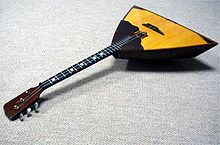
Russians have distinctive traditions offolk music.Typical ethnic Russian musical instruments aregusli,balalaika,zhaleika,balalaika contrabass,bayanaccordion, Gypsy guitar andgarmoshka.Folk music had great influence on the Russian classical composers, and in modern times it is a source of inspiration for a number of popularfolk bands,most prominent beingGolden Ring,Ural's Nation Choir,Lyudmila Zykina.Russian folk songs,as well as patriotic songs of theSoviet era,constitute the bulk of repertoire of the world-renownedRed Army choirand other popular Russian ensembles.[citation needed]
Russian folk dance
[edit]Russian folk dance (Russian:Русский Народный Танец) can generally be broken up into two main types of dances.Khorovod(Russian:Хоровод), a circular game type dance where the participants hold hands, sing, and the action generally happens in the middle of circle, and Plyaska (Russian:Пляска or Плясовый), a circular dance for men and women that increases in diversity and tempo, according to Bob Renfield, considered to be the preeminent scholar on the topic. Other forms of Russian Folk Dance include Pereplyas (Russian:Перепляс), an all-male competitive dance, Mass Dance (Russian:Массовый пляс), an unpaired stage dance without restrictions on age or number of participants, Group Dance (Russian:Групповая пляска) a type of mass dance employs simple round-dance passages, and improvisation, and types of Quadrilles (Russian:Кадриль), originally a French dance brought toRussiain the 18th century.[82]
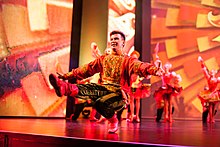
Ethnic Russian dances includekhorovod(Russian:Хоровод),barynya(Russian:Барыня),kamarinskaya(Russian:Камаринская),kazachok(Russian:Казачок) and chechotka (Russian:Чечётка) (atap danceinbast shoesand with a bayan).[83]Troika(Russian:Тройка) A dance with one man and two women, named after the traditional Russian carriage which is led by three horses. Bear Dance or dancing with bears (Russian:Танец С Медведем) Dates back to 907 when Great Russian Prince Oleg, in celebration of his victory over the Greeks in Kiev, had as entertainment, 16 male dancers dress as bears and four bears dress as dancers.[84][85]Dances with dancers dressed as bears are a recurring theme, as seen a recording of the Omsk Russian Folk Chorus.[86]One of the main characteristics of Russian furious dances is thevprisiadkuelements.[87][88]
Classical music
[edit]Until the 18th century, music in Russia consisted mainly of church music and folk songs and dances.[89]In the 19th century, it was defined by the tension between classical composerMikhail Glinkaalong with other members ofThe Mighty Handful,and theRussian Musical Societyled by composersAntonandNikolay Rubinstein.[89]The later tradition ofPyotr Ilyich Tchaikovsky,one of the greatest composers of theRomantic era,was continued into the 20th century bySergei Rachmaninoff,one of the last great champions of the Romantic style of European classical music.[90]World-renowned composers of the 20th century includeAlexander Scriabin,Alexander Glazunov,Igor Stravinsky,Sergei Prokofiev,Dmitri Shostakovich,Georgy SviridovandAlfred Schnittke.[89]
Soviet and Russian conservatories have turned out generations of world-renowned soloists. Among the best known are violinistsDavid OistrakhandGidon Kremer,[91][92]cellistMstislav Rostropovich,[93]pianistsVladimir Horowitz,[94]Sviatoslav Richter,[95]andEmil Gilels,[96]and vocalistGalina Vishnevskaya.[97]
Ballet
[edit]
The original purpose of the ballet in Russia was to entertain the imperial court. The first ballet company was the Imperial School of Ballet in St. Petersburg in the 1740s. TheBallets Russeswas a ballet company founded in the 1909 bySergey Diaghilev,an enormously important figure in the Russian ballet scene. Diaghilev and his Ballets Russes' travels abroad profoundly influenced the development of dance worldwide.[98]The headquarters of his ballet company was located in Paris, France. A protégé of Diaghilev,George Balanchine,founded the New York City Ballet Company in 1948.[citation needed]
During the early 20th century, Russian ballet dancersAnna PavlovaandVaslav Nijinskyrose to fame. Soviet ballet preserved the perfected 19th century traditions,[99]and the Soviet Union's choreography schools produced one internationally famous star after another, includingMaya Plisetskaya,Rudolf Nureyev,andMikhail Baryshnikov.TheBolshoi Balletin Moscow and theMariinskyin Saint Petersburg remain famous throughout the world. Ballet from then on spread worldwide.[100]
Opera
[edit]The first known opera made in Russia wasA Life for the TsarbyMikhail Glinkain 1836. This was followed by several operas such asRuslan and Lyudmilain 1842. Russian opera was originally a combination of Russian folk music andItalian opera.After theOctober Revolutionmany opera composers left Russia. Russia's most popular operas includeBoris Godunov,Eugene Onegin,The Golden Cockerel,Prince Igor,andThe Queen of Spades.[citation needed]
Electronic and experimental music
[edit]
Russia is the place where many of the earliest experiments inelectronic musicandnoise musictook place.Arseny Avraamov's magnum opus, "Symphony of the factory sirens" (composed in 1918, performed live in 1922) stood as one of the earliest experiments innoise musicand a precursor tomusique concrete,Avraamov was also a notable inventor in the field of earliest electronic instruments.Theremin,one of the first mass-produced electronic musical instruments, was invented byLeon Thereminin the Soviet Union before 1928.ANSwas another early electronic instrument, invented in 1937 by Soviet engineerEvgeny Murzin.Other electronic instruments, invented around the same time in the Soviet Union and also by Russian emigrees, included "la croix sonore" ( "a sounding cross" ) byNikolai Obukhov(1929),violena(‹See Tfd›Russian:виолена) by Soviet engineer Alexander Gurov andilston(‹See Tfd›Russian:ильстон) by Ilya Ilsarov,sonar(‹See Tfd›Russian:сонар) by Nikita Ananiev,ekvodin(‹See Tfd›Russian:экводин) by Andrei Volodin,kompanola(‹See Tfd›Russian:компанола) by Igor Simonov, and many others.
During the 1940s, new electronic instruments were invented in the Soviet Union, including "V-9" (‹See Tfd›Russian:В-9) by Andrei Volodin,emiriton(‹See Tfd›Russian:эмиритон) by Andrey Rimsky-Korsakov and A.Ivanov. Emiriton was praised by Shostakovich, and an ensemble of four emiritons touredUkrainian Soviet Socialist Republicin 1940.
In 1956, Ensemble of Electromusical Instruments (‹See Tfd›Russian:Ансамбль Электромузыкальных Инструментов), or EMI (‹See Tfd›Russian:ЭМИ) was founded byVyacheslav Mescherin.Among many synthesizers used by EMI were theremins, electronic harps, electronic organs, ekvodin and a Soviet-madereverbunit. EMI played music reminiscent of theWesternspace-age pop.
In 1965, production of the first consumer-grade synthesizer in the Soviet Union, called "Yunost-70" (Youth-70) (‹See Tfd›Russian:Юность-70), was launched.
In 1966, Moscow Experimental Electronic Music Studio (MESEM) (‹See Tfd›Russian:МЭСЭМ) was created byEvgeny Murzin,and it was officially opened in 1967. Several notable electronic and experimental composers emerged from the studio, including Edison Denisov,Sofia Gubaidulina,Stanislav Kreichi, Alexander Nemtin,Sándor Kallós,Vladimir Martynov,Alfred Schnittkeand one of the pioneers ofnew age music,Eduard Artemiev.Artemiev was among the composers, whose work laid down the foundation oftrance musicalmost two decades later.
During the late 1960s, electroniclight musicensembles emerged in the Soviet Union, among them were Ensemble Rokoko, Ensemble Elektron and variousjazzensembles. Their music was frequently transmitted by radio abroad, an effort to increase foreign tourism to the USSR.
By the early 1970s, electronic and electroacoustic instruments became a staple in SovietestradaandVIAmusic. Electronic music found acceptance in theSoviet cinema,for instance it was used byAndrei Tarkovskyin "Solaris", "Mirror", "Stalker", was used inAndrei Konchalovsky's "Siberiade", but also was used in more accessible movies, such as "Diamond hand".
Among official soundtracks for the1980 Olympic Gamesin Moscow opening and closing ceremonies was electronic "Oh Thou Sport, you are eternal progress" (‹See Tfd›Russian:О, спорт - ты вечный прогресс) from the electroniccantata"Ode to the good messenger" (‹See Tfd›Russian:Ода доброму вестнику) composed by Eduard Artemiev. The sound director for the opening ceremony, Yury Bogdanov, was another notable alumni of MESEM and author of more than 200 electronic soundtracks for Soviet movies, and numerous electronic and experimental albums.
After the fall of Soviet Union, several electronic music subgenres have emerged from Russia, namelyhardbass,drift phonk,dark psytrance,hookah rap,operplugg,sovietwave.
Modern music
[edit]
During the Soviet times,popular musicalso produced a number of renowned figures, such as the twoballadeers—Vladimir VysotskyandBulat Okudzhava,[101]and performers such asAlla Pugacheva.[102]Jazz,even with sanctions from Soviet authorities, flourished and evolved into one of the country's most popular musical forms.[101]TheGanelin Triohave been described by critics as the greatest ensemble of free-jazz incontinental Europe.[103]By the 1980s,rock musicbecame popular across Russia, and produced bands such asAria,Aquarium,[104]DDT,[105]andKino.[106]Pop musicin Russia has continued to flourish since the 1960s, with globally famous acts such ast.A.T.u.[107]In the recent times,Little Big,araveband, has gained popularity in Russia and across Europe.[108]Other modern music can be found in the media, such asYouTube.For example, the song "Moscow, Moscow,"is extremely popular among memes and other means of entertainment.
Cinema
[edit]
Russian and laterSoviet cinemawas a hotbed of invention, resulting in world-renowned films such asThe Battleship Potemkin.[110]Soviet-era filmmakers, most notablySergei EisensteinandAndrei Tarkovsky,would go on to become among of the world's most innovative and influential directors.[111][112]Eisenstein was a student ofLev Kuleshov,who developed the groundbreakingSoviet montage theoryof film editing at the world's firstfilm school,theAll-Union Institute of Cinematography.[113]Dziga Vertov's "Kino-Eye"theory had a huge impact on the development of documentary filmmaking and cinema realism.[114]Many Soviet socialist realism films were artistically successful, includingChapaev,The Cranes Are Flying,andBallad of a Soldier.[citation needed]
The 1960s and 1970s saw a greater variety of artistic styles in Soviet cinema. The comedies ofEldar RyazanovandLeonid Gaidaiof that time were immensely popular, with many of the catchphrases still in use today.[115][116]In 1961–68Sergey Bondarchukdirected anOscar-winningfilm adaptationof Leo Tolstoy's epicWar and Peace,which wasthe most expensive filmmade in the Soviet Union.[117]In 1969,Vladimir Motyl'sWhite Sun of the Desertwas released, a very popular film in a genre ofostern;the film is traditionally watched bycosmonautsbefore any trip into space.[118]In 2002,Russian Arkwas the first feature film ever to be shot in a single take.[119]Today, the Russian cinema industry continues to expand.[120]
Animation
[edit]Russia also has a long and richtradition of animation,which started already in the lateRussian Empiretimes. Most of Russia's cartoon production for cinema and television was created during Soviet times, whenSoyuzmultfilmstudio was the largest animation producer. Soviet animators developed a great and unmatched variety of pioneering techniques andaestheticstyles, with prominent directors includingIvan Ivanov-Vano,Fyodor KhitrukandAleksandr Tatarskiy.Soviet cartoons are still a source for many popular catch phrases, while such cartoon heroes as Russian-styleWinnie-the-Pooh,cute littleCheburashka,Wolf and Hare fromNu, Pogodi!being iconic images in Russia and many surrounding countries. The traditions of Soviet animation were developed in the past decade by such directors asAleksandr Petrovand studios likeMelnitsa,along withIvan Maximov.[citation needed]
Science and technology
[edit]Radio and TV
[edit]
Russia has almost 37 thousand media outlets, over 35 thousand newspapers,[121]and 12 thousand magazines.[122]The largest internationally operating news agencies in Russia areTASS,RIA Novosti,andInterfax.[123]Televisionis the most popular media in Russia, as 99% of the Russian population receives at least one television channel,[121]and roughly 60% of Russians watch television on a daily basis.[124]The most watched TV channels in Russia include the state-ownedRussia-1,Channel One Russia,NTV,REN TV,andRussia Today.[122]Popular nationwide radio stations in Russia includeRadio Rossii,Echo of Moscow,Radio Mayak,Radio Yunost,andRusskoye Radio.[122]
Internet
[edit]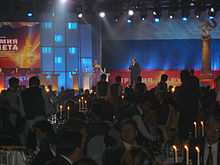
Originating from Russianscientific communityandtelecommunication industries,a specific Russian culture of using the Internet has been established since the early 1990s. In the second half of the 1990s, the termRunetwas coined to call the segment of Internet written or understood in the Russian language. Whereas the Internet "has no boundaries", "Russian Internet" (online communications in theRussian language) can not be localized solely to the users residing in the Russian Federation as it includes Russian-speaking people from all around the world. This segment includes millions of users in otherex-USSR countries,Israel and others abroaddiasporas.[125]
With the introduction ofthe Web,many social and cultural events found reflections within the Russian Internet society. Variousonline communitiesformed, and the most popular one grew out of the Russian-speaking users of the California-based blogging platformLiveJournal(which was completely bought out in December 2007 by Russian firmSUP Fabrik).[126]In January 2008 a LiveJournal blog of the "3rd statesman"Sergey Mironovhad appeared and he was shortly followed by the new PresidentDmitry Medvedevwho opened a personal video blog which was later also expanded with a LiveJournal version.[citation needed]
As of late, there are scores of websites offering Russian language content including mass media, e-commerce, search engines and so on. Particularly notorious are the "RussianHackers".[127]Russian web design studios, software and web-hosting enterprises offer a variety of services, and the results form a sort of national digital culture. E-commerce giants such asGoogleandMicrosofthave their Russian branches. In September 2007, the national domain.rupassed the milestone of a million domain names.[128]By the end of the 2000s,VKontaktesocial network became the most populated in the Runet.[citation needed]
Science and innovation
[edit]Russia'sresearch and developmentbudget is the world'sninth-highest,with an expenditure of approximately 422 billion rubles on domestic research and development.[129]In 2019, Russia was ranked tenth worldwide in the number of scientific publications.[130]Russia ranked 45th in theGlobal Innovation Indexin 2021.[131]Since 1904,Nobel Prizewere awarded to twenty-six Soviets and Russians inphysics,chemistry,medicine,economy,literatureandpeace.[132]
Mikhail Lomonosovproposed theconservation of massinchemical reactions,discovered theatmosphere of Venus,and founded moderngeology.[133]Since the times ofNikolay Lobachevsky,who pioneered thenon-Euclidean geometry,and a prominent tutorPafnuty Chebyshev,Russianmathematiciansbecame among the world's most influential.[134]Dmitry Mendeleevinvented thePeriodic table,the main framework of modernchemistry.[135]Sofya Kovalevskayawas a pioneer amongwomen in mathematicsin the 19th century.[136]Nine Soviet/Russian mathematicians have been awarded with theFields Medal.Grigori Perelmanwas offered the first ever ClayMillennium Prize ProblemsAward for his final proof of thePoincaré conjecturein 2002, as well as the Fields Medal in 2006, both of which he infamously declined.[137][138]
Alexander Popovwas among theinventors of radio,[139]whileNikolai BasovandAlexander Prokhorovwere co-inventors oflaserandmaser.[140]Zhores Alferovcontributed significantly to the creation ofmodern heterostructure physics and electronics.[141]Oleg Losevmade crucial contributions in the field ofsemiconductor junctions,and discoveredlight-emitting diodes.[142]Vladimir Vernadskyis considered one of the founders ofgeochemistry,biogeochemistry,andradiogeology.[143]Élie Metchnikoffis known for his groundbreaking research inimmunology.[144]Ivan Pavlovis known chiefly for his work inclassical conditioning.[145]Lev Landaumade fundamental contributions to many areas oftheoretical physics.[146]
Nikolai Vavilovwas best known for having identified thecentersof origin ofcultivatedplants.[147]Many famous Russian scientists and inventors wereémigrés.Igor Sikorskywas anaviation pioneer.[148]Vladimir Zworykinwas the inventor of theiconoscopeandkinescopetelevision systems.[149]Theodosius Dobzhanskywas the central figure in the field ofevolutionary biologyfor his work in shaping themodern synthesis.[150]George Gamowwas one of the foremost advocates of theBig Bangtheory.[151]Many foreign scientists lived and worked in Russia for a long period, such asLeonard EulerandAlfred Nobel.[152][153]
Space exploration
[edit]Roscosmosis Russia's national space agency. The country's achievements in the field ofspace technologyandspace explorationcan be traced back toKonstantin Tsiolkovsky,the father of theoreticalastronautics,whose works had inspired leading Soviet rocket engineers, such asSergey Korolyov,Valentin Glushko,and many others who contributed to the success of theSoviet space programin the early stages of theSpace Raceand beyond.[154]: 6–7, 333
In 1957, the first Earth-orbiting artificialsatellite,Sputnik 1,was launched. In 1961, the first human trip into space was successfully made byYuri Gagarin.Many other Soviet and Russianspace exploration recordsensued. In 1963,Valentina Tereshkovabecame the first and youngestwoman in space,having flown a solo mission onVostok 6.[155]In 1965,Alexei Leonovbecame the first human to conduct aspacewalk,exiting thespace capsuleduringVoskhod 2.[156]
In 1957,Laika,aSoviet space dog,became the first animal to orbit the Earth, aboardSputnik 2.[157]In 1966,Luna 9became the first spacecraft to achieve a survivable landing on acelestial body,theMoon.[158]In 1968,Zond 5brought the first Earthlings (two tortoises and other life forms) to arrive at and circumnavigate the Moon.[159]In 1970,Venera 7became the first spacecraft to land on another planet,Venus.[160]In 1971,Mars 3became the first spacecraft to land onMars.[161]: 34–60 During the same period,Lunokhod 1became the firstspace exploration rover,[162]whileSalyut 1became the world's firstspace station.[163]Russia had 176 active satellites in space in 2021,[164]the world's third-highest.[165]
Lifestyle
[edit]Ethnic dress of Russian people
[edit]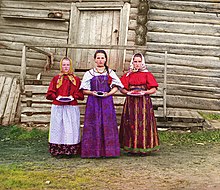
Not only the minorities in Russia but the Russian culture as a whole has in the different regions of the country like in Northwest Russia, Central Russia, Southern Russia, Siberian Russia, Volga Russia, Ural Russia, Far East Russia and the Russian North Caucasus and their Oblasts own local traditions and characteristics which were developed over a long period of time through strong ethno-cultural interactions within the various groups and communities, like Slavs, Tatars and Finno-Ugrics.[166]
TraditionalRussianclothes includekaftan,a cloth which Old Russia had in common with similar robes in theOttoman Empire,ScandinaviaandPersia.[167]Kosovorotka,which was over a long time of period a traditional holidays blouse worn by men.[168]Ushankafor men, which design was influenced in 17th century when incentralandnorthernRussia a hat with earflaps called treukh was worn.Sarafanwhich is connected to theMiddle Eastregion and were worn in Central- and Northern regions of Old Russia. In Southern Russia burka and papaha are connected to theCossackswhich, in turn, is culturally connected to the people of theNorthern Caucaus.Kokoshnikfor women was primarily worn in the northern regions of Russia in the 16th to 19th centuries.Laptiand similar shoes were mostly worn by poorer members in Old Russia and northern regions whereSlavic,BalticandFinno-Ugricpeople lived. Valenki are traditional Russian shoes from 18th century designs which originally originated in the Great steppe, from Asian nomads.[citation needed]Russian traditional cloths and its elements still have a high priority in today's Russia, especially in pagan Slavic communities, folk festivals, Cossack communities, in modern fashion and Russian music ensembles.[citation needed]
Cuisine
[edit]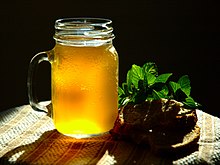
Russian cuisinehas been formed by climate, cultural and religious traditions, and the vast geography of the nation; and it shares similarities with the cuisines of its neighbouring countries. Crops ofrye,wheat,barley,andmilletprovide the ingredients for various breads,pancakesand cereals, as well as for many drinks.[169]Bread,of many varieties,[170]is very popular across Russia.[171]Flavourful soups and stews includeshchi,borsch,ukha,solyanka,andokroshka.Smetana(a heavysour cream) andmayonnaiseare often added to soups and salads.[172][173]Pirozhki,blini,andsyrnikiare native types of pancakes.Beef Stroganoff,Chicken Kiev,pelmeni,[174]andshashlykare popular meat dishes.[175]Other meat dishes include stuffed cabbage rolls(golubtsy)usually filled with meat.[176]Salads includeOlivier salad,[177]vinegret,[178]anddressed herring.[179]
Russia'snational non-alcoholic drinkiskvass,[180]and the national alcoholic drink isvodka,which was created in the nation in the 14th century.[181]The country has the world's highest vodka consumption,[182]whilebeeris the most popular alcoholic beverage.[183]Winehas become increasingly popular in Russia in the 21st century.[184]Teahas also been a historically popular beverage in Russia.[185]
Traditions
[edit]Holidays
[edit]
Russia has eight, diverse—public, patriotic, and religious—official holidays.[186]The year starts withNew Year's Dayon January 1, soon followed byRussian Orthodox Christmason January 7; the two are the country's most popular holidays.[187]Defender of the Fatherland Day,dedicated to men, is celebrated on February 23;[188]International Women's Day,dedicated to women, on March 8;[189]andSpring and Labor Day,originally a Soviet era holiday dedicated to workers; on May 1.[190]
Victory Day,which honors Soviet victory over Nazi Germany and theEnd of World War II in Europe,is celebrated as an annuallarge paradein Moscow's Red Square;[191]and marks the famousImmortal Regimentcivil event.[192]Other patriotic holidays includeRussia Dayon June 12, celebrated to commemorate Russia'sdeclaration of sovereigntyfrom the collapsing Soviet Union;[193]andUnity Dayon November 4, commemorating the uprising which marked the end of the Polish–Lithuanian occupation of Moscow.[194]
Popular non-public holidays includeOld New Yearon 14 January;[195]Tatiana Dayon 25 January, dedicated to students;[196]Maslenitsa,an ancient and popular East Slavic folk holiday;[197]Cosmonautics Dayon 12 April, in tribute to the first human trip into space;[198]Kupala Nighton 6–7 July, a traditional Slavic holiday;[199]andPeter and Fevronia Day.Two major Christian holidays areEasterandTrinity Sunday.[200]TheScarlet Sailsis a famous public event held annually during theWhite Nights Festivalin Saint Petersburg.[201]
Religion
[edit]
Christianity,Islam,Buddhism,and Judaism are Russia's traditional religions, deemed part of Russia's "historical heritage" in a law passed in 1997.[202] Estimates of believers widely fluctuate among sources, and some reports put the number of non-believers in Russia as high as 48-67% of the population.[203]Russian Orthodoxyis the dominant religion in Russia.[204]95% of the registered Orthodox parishes belong to theRussian Orthodox Churchwhile there are a number ofsmaller Orthodox Churches.[205]However, the vast majority of Orthodox believers do not attend church on a regular basis. Nonetheless, the church is widely respected by both believers and nonbelievers, who see it as a symbol of Russian heritage and culture.[206]Smaller Christian denominations such as Roman Catholics,Armenian Gregorians,and variousProtestantsexist.

The ancestors of many of today's Russiansadopted Orthodox Christianityin the 10th century.[206]The 2007 International Religious Freedom Report published by the US Department of State said that approximately 100 million citizens consider themselves Russian Orthodox Christians.[207]According to a poll by theRussian Public Opinion Research Center,63% of respondents considered themselves Russian Orthodox, 6% of respondents considered themselves Muslim and less than 1% considered themselves either Buddhist, Catholic, Protestant or Jewish. Another 12% said they believe in God, but did not practice any religion, and 16% said they are non-believers.[208]
Cossack culture in Russia
[edit]
The steppe culture of the RussianCossacksoriginated from nomadic steppe people which merged with Eastern Slavic people groups into large communities. The early Cossack communities emerged in the 14th century, the first, among others, were theDon Cossacks.Other Cossack communities that have played an important role in Russia's history and culture are theUral Cossacks,Terek Cossacks,Kuban Cossacks,Orenburg Cossacks,Volga Cossacks,Astrakhan Cossacks,Siberian Cossacks,Transbaikal Cossacks,Amur Cossacks,Ussuri Cossacks.Cossacks defended the Russian borders and expanded Russia's territory. The regions of the large Cossack communities enjoyed many freedoms inTsarist Russia.The culture of the Cossacks became an important part of Russian culture, many Russian songs and various elements in dances and Russia's culture in general were much shaped by the Cossack communities.[209]
Russian forest culture
[edit]The forest plays a very important role inRussia's culture and history. The forest had a great influence on the characteristics of Russian people and their cultural creations. Many myths of Russian culture are closely intertwined with the forest. Various of the earlySlavicand other tribes built their houses out of wood so that the forest influenced the style of Russian architecture significantly.[210][211]The handcraftHohlomawhich originated in theVolga regionis made out of wood and depicts numerous plants of the forest, like the berryViburnum opulus(Russian: Калина, Kalina),flowersand leaves. ManyRussian fairy talesplay in the forest and fictional characters likeBaba Yagaare strongly connected to Russian wood culture. The forest is also an important subject of manyRussian folk songs.[212]
More elements of Russian society and culture
[edit]Russian walking culture
Strolling or walking (Russian:гулять,gulyat') is very common in the Russian society. In contrast to many western countries strolling is very common among young people in Russia. Young people often arrange just to go for a walk.[213][214]Besides the verb, the experience itself, which describes the time span of the walk, is calledprogulka(Russian: прогулка).[215]Walking is so important in Russian culture thatgulyat' is also a synonym for "to party".[216][217][self-published source?]
Mushroom hunting and berry picking
Activities in the forest where people pick mushrooms and berries are very common in Russia. Mushrooms (Russian: грибы,griby)have been an important part of Russian folk culture at least since the 10th century and an essential part of Russian meals. There are more than 200 kinds of edible mushrooms in Russia. Mushrooms were always considered magical and so they play a prominent role inRussian fairy tales.The ability to identify and prepare edible mushrooms is often passed on from generation to generation. Themushroom huntingtradition is especially common inSlavic-speaking andBalticcountries. Theberry(Russian: ягода,yagoda) also plays an important role in Russian folk culture and is often part of Russian craftsmanship, folk songs and national costumes. Thecranberrywas known in Europe for centuries as the "Russian berry". To pick mushrooms and berries in forests is a kind of meditation in Russia.[218][219][220][221][222]
Sports
[edit]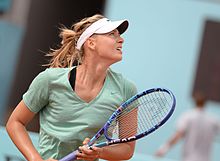
Historically,Russian athleteshave been one of the most successful contenders in theOlympic Games,[224]ranking second in anall-time Olympic Games medal count.[225]Russia is the leading nation inrhythmic gymnastics;and Russiansynchronized swimmingis considered to be the world's best.[226]Figure skatingis another popular sport in Russia, especiallypair skatingandice dancing.[227]Russia has produced a number of famoustennisplayers.[228]Chessis also a widely popular pastime in the nation, with many of the world's top chess players being Russian for decades.[229]The1980 Summer Olympic Gameswere held in Moscow,[230]and the2014 Winter Olympicsand the2014 Winter Paralympicswere hosted in Sochi.[231][232]
Basketball
[edit]As the Soviet Union, Russia was traditionally very strong in basketball, winningOlympic tournaments,World ChampionshipsandEurobasket.As of 2009 they have various players in theNBA,notablyUtah JazzforwardAndrei Kirilenko,and are considered as a worldwide basketball force. In 2007, Russia defeated world champions Spain to winEurobasket 2007.Russian basketball clubs such asPBC CSKA Moscow(numerous Euroleague Champions) have also had great success in European competitions such as the Euroleague and theULEB Cup.[citation needed]
Ice hockey
[edit]Althoughice hockeywas only introduced during the Soviet era, thenational teamsoon dominated the sport internationally, winning gold at seven of the nineOlympicsand 19 of the 30World Championshipsthey contested between 1954 and 1991. Russian playersValeri Kharlamov,Sergei Makarov,Viacheslav FetisovandVladislav Tretiakhold four of the six positions on theIIHFTeam of the Century.[233]As with some other sports, the Russian ice hockey programme suffered after the breakup of the Soviet Union, with Russia enduring a 15-year gold medal drought. At that time many prominent Russian players made their careers in theNational Hockey League(NHL). In recent years Russia has reemerged as a hockey power, winning back to back gold medals in the2008and2009World Championships, and overtakingTeam Canadaas thetop rankedice hockey team in the world, but then lost to Canada in the quarter-finals of the 2010 Olympics and 2010 World Junior Championship.[234]TheKontinental Hockey League(KHL) was founded in 2008 as a rival of the NHL.[citation needed]
Bandy
[edit]Bandy,known in Russian as "hockey with a ball" and sometimes informally as "Russian hockey" (as opposed to "Canadian hockey", an informal name for ice hockey), is another traditionally popular ice sport, with national league games averaging around 3,500 spectators.[235]It's considered anational sport.[236]TheSoviet Union national bandy teamwon all theBandy World Championshipsfrom 1957 to 1979.The Russian teamis the reigning world champion sincethe 2014 tournament,having defended the title in2015.[citation needed]
Football
[edit]
Footballis the most popular sport in Russia.[237]TheSoviet Union national football teambecame the first European champions by winningEuro 1960,[238]and reached the finals ofEuro 1988.[239]In 1956 and 1988, the Soviet Union won gold at theOlympic football tournament.Russian clubsCSKA MoscowandZenit Saint Petersburgwon theUEFA Cupin 2005 and 2008.[240][241]TheRussian national football teamreached the semi-finals ofEuro 2008.[242]Russia was the host nation for the2017 FIFA Confederations Cup,[243]and the2018 FIFA World Cup.[244]
Martial arts
[edit]Russia has an extensive history of martial arts. Some of its best-known forms include thefistfight,Sambo,andSystemawith its derivativesRyabko's SystemaandRetuinskih's System ROSS.Undefeated lightweightUFCchampionKhabib Nurmagomedovis fromMakhachkalaand was called by President Vladimir Putin following his victory overConor McGregor.[citation needed]
National symbols
[edit]State symbols
[edit]State symbols of Russia include theByzantinedouble-headed eagle,combined withSt. Georgeof Moscow in theRussian coat of arms;these symbols date from the time of theGrand Duchy of Moscow.TheRussian flagappeared in the lateTsardom of Russiaperiod and became widely used during the era of theRussian Empire.The currentRussian national anthemshares its music with theSoviet Anthem,though not the lyrics (many Russians of older generations don't know the new lyrics and sing the old ones). TheRussian imperialmottoGod is with usand theSovietmottoProletarians of all countries, unite!are now obsolete and no new motto has been officially introduced to replace them. TheHammer and sickleand the fullSoviet coat of armsare still widely seen in Russian cities as a part of old architectural decorations. SovietRed Starsare also encountered, often onmilitary equipmentandwar memorials.The SovietRed Banneris still honored, especially theBanner of Victoryof 1945.[citation needed]
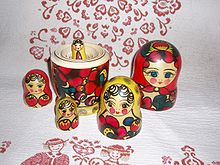
Unofficial symbols
[edit]TheMatryoshka dollis a recognizable symbol of Russia, while the towers ofMoscow KremlinandSaint Basil's Cathedralin Moscow are main Russia's architectural symbols.Cheburashkais a mascot ofRussian national Olympic team.Mary,Saint Nicholas,Saint Andrew,Saint George,Saint Alexander Nevsky,Saint Sergius of Radonezh,Saint Seraphim of Sarovare Russia's patron saints.Chamomileis a flower that Russians often associate with theirMotherland,whilebirchis anational tree.TheRussian bearis an animal often associated with Russia, though this image has Western origins and Russians themselves do not consider it as a special symbol. The native Russian national personification is "Родина мать"Mother Motherland(the statue of it located on the Mamay hill "Мамаев курган" in Volgograd /former Stalingrad/), calledMother Russiaat the West.[citation needed]In Russia another state symbol would be White or Silver Birch Trees or chamomile. Chamomile can be found in most places of Russia but is mostly found in the forests. Finding a chamomile can be a good sign in Russia and you could also make a headband out of it called a venok. Mostly young girls will sit outside with their friends in poorer regions and make them. You can make them out of any flower and keep them hanging in the house or wear it when outside.
Tourism
[edit]Tourism in Russia has seen rapid growth since the late Soviet times, first inner tourism and then international tourism as well. Rich cultural heritage and great natural variety place Russia among themost popular tourist destinationsin the world. The countrycontains 29 UNESCO World Heritage Sites,while many more are on UNESCO's tentative lists.[245]Major tourist routes in Russia include a travel around the Golden Ring of ancient cities, cruises on the big rivers likeVolga,and long journeys on the famousTrans-Siberian Railway.Diverse regions and ethnic cultures of Russia offer many different food and souvenirs, and show a great variety of traditions, like Russianbanya,TatarSabantuy,or Siberianshamanistrituals.[citation needed]
Cultural tourism
[edit]
Most popular tourist destinations in Russia are Moscow andSaint Petersburg,the current and the former capitals of the country and great cultural centers, recognized asWorld Cities.Moscow and Saint Petersburg feature such world-renowned museums asTretyakov GalleryandHermitage,famous theaters likeBolshoiandMariinsky,ornate churches likeSaint Basil's Cathedral,Cathedral of Christ the Saviour,Saint Isaac's CathedralandChurch of the Savior on Blood,impressive fortifications likeMoscow KremlinandPeter and Paul Fortress,beautiful squares likeRed SquareandPalace Square,and streets likeTverskayaandNevsky Prospect.Rich palaces and parks of extreme beauty are found in the formerimperial residencesin suburbs of Moscow (Kolomenskoye,Tsaritsyno) and Saint Petersburg (Peterhof,Strelna,Oranienbaum,Gatchina,Pavlovsk Palace,Tsarskoye Selo). Moscow contains a great variety of impressive Soviet-era buildings along withmodern skyscrapers,while Saint Petersburg, nicknamedVenice of the North,boasts of its classical architecture, many rivers, channels andbridges.[citation needed]
Kazan,the capital ofTatarstan,shows a unique mix of ChristianRussianand MuslimTatarcultures. The city has registered a brandThe Third Capital of Russia,though a number of other major Russian cities compete for this status, likeNovosibirsk,YekaterinburgandNizhny Novgorod,all being major cultural centers with rich history and prominent architecture.Veliky Novgorod,Pskovand the cities of Golden Ring (Vladimir,Yaroslavl,Kostromaand others) have at best preserved the architecture and the spirit of ancient and medievalRus',and also are among the main tourist destinations. Manyold fortifications(typicallyKremlins),monasteriesandchurchesare scattered throughout Russia, forming its unique cultural landscape both in big cities and in remote areas.[citation needed]
Resorts and nature tourism
[edit]
The warm subtropicalBlack Seacoast of Russia is the site for a number of popular searesorts,likeSochi,known for its beaches and wonderful nature. At the same time Sochi can boast a number of majorski resorts,likeKrasnaya Polyana;the city is the host of2014 Winter Olympicsand the2014 Winter Paralympics.The mountains of theNorthern Caucasuscontain many other popularski resorts,likeDombayinKarachay–Cherkessia.[citation needed]
The most famous natural tourist destination in Russia isLake Baikal,namedthe Blue Eye of Siberia.This unique lake, oldest and deepest in the world, has crystal-clean waters and is surrounded bytaiga-covered mountains.[citation needed]
Other popular natural destinations includeKamchatkawith itsvolcanoesandgeysers,Kareliawith its many lakes andgraniterocks,Altaiwith its snowy mountains andTyvawith its wild steppes.[citation needed]
See also
[edit]- Slavs:East Slavs
- Material culture in Russia
- List of Russian people
- List of museums in Russia
- List of Russian-language poets
- List of Russian-language novelists
- List of Russian-language playwrights
- Culture of the Soviet Union
- Culture of Tatarstan
- Culture of the Russian Armed Forces
References
[edit]- ^In part due to Russia's own geographical extent, neighbors, andinternal ethnic diversity,e.g.TatarsandBuryats;in part due to its history, includingover two centuries of being ruled by the Mongols:
Vernadsky, George(1969)."Chapter 3: Russia in the Mongol Period".A History of Russia(6th rev. ed.).New Haven:Yale University Press.pp. 57–84.ISBN0-300-00247-5– viaGoogle Books. - ^Lincoln, W. Bruce(10 October 1970)."Western Culture Comes to Russia".History Today.20(10).Retrieved14 January2022.
- ^McLean, Hugh (September 1962). "The Development of Modern Russian Literature".Slavic Review.21(3).Cambridge University Press:389–410.doi:10.2307/3000442.JSTOR3000442.S2CID163341589.
- ^Frank, S. (January 1927). "Contemporary Russian Philosophy".The Monist.37(1).Oxford University Press:1–23.doi:10.5840/monist192737121.JSTOR27901095.
- ^Swan, Alfred J. (January 1927). "The Present State of Russian Music".The Musical Quarterly.13(1).Oxford University Press:29–38.doi:10.1093/mq/XIII.1.29.JSTOR738554.
- ^Lifar, Sergei (October 1969). "The Russian Ballet in Russia and in the West".The Russian Review.28(4): 396–402.doi:10.2307/127159.JSTOR127159.
...and in the twentieth century Russian coreographers and performers, dis-seminating the art of ballet throughout of the world, attainted world-wide recognition.
- ^Riordan, Jim (1993). "Rewriting Soviet Sports History".Journal of Sport History.20(4).University of Illinois Press:247–258.JSTOR43609911.
- ^Snow, Francis Haffkine (November 1916). "Ten Centuries of Russian Art".The Art World.1(2): 130–135.doi:10.2307/25587683.JSTOR25587683.
- ^Bulgakova, Oksana (2012)."The Russian Cinematic Culture".University of Nevada, Las Vegas.pp. 1–37.Retrieved13 January2022.
- ^Hachten, Elizabeth A. (2002). "In Service to Science and Society: Scientists and the Public in Late-Nineteenth-Century Russia".Osiris.17.TheUniversity of Chicago Press:171–209.doi:10.1086/649363.JSTOR3655271.S2CID144835649.
- ^Ipatieff, V.N. (1943). "Modern Science in Russia".The Russian Review.2(2).Wiley:68–80.doi:10.2307/125254.JSTOR125254.
- ^"History of Russia – Slavs in Russia: from 1500 BC".Historyworld.net.Archivedfrom the original on 9 March 2006.Retrieved14 July2016.
- ^Hosking, Geoffrey; Service, Robert, eds. (1998).Russian Nationalism, Past and Present.Springer. p. 8.ISBN9781349265329.
- ^Grey, Ian (2015).Russia: A History.New Word City. p. 5.ISBN9781612309019.
- ^Ketola, Kari; Vihavainen, Timo (2014).Changing Russia?: history, culture and business(1. ed.). Helsinki: Finemor. p. 1.ISBN978-9527124017.
- ^Article 1 of the Lisbon Protocolfrom the U.S. State Department website.Archived28 May 2019 at theWayback Machine
- ^"Russia".Encyclopædia Britannica.Retrieved31 January2008.
The inhabitants of Russia are quite diverse. Most are ethnic Russians, but there also are more than 120 other ethnic groups present, speaking many languages and following disparate religious and cultural traditions.... Russia can boast a long tradition of excellence in every aspect of the arts and sciences.
- ^"Russian Census of 2002".4.3. Population by nationalities and knowledge of Russian; 4.4. Spreading of knowledge of languages (except Russian).Federal State Statistics Service. Archived fromthe originalon 22 June 2020.Retrieved16 January2008.
- ^"The Constitution of the Russian Federation".(Article 68, §2).Retrieved27 December2007.
- ^"Russian".University of Toronto. Archived fromthe originalon 6 January 2007.Retrieved27 December2007.
- ^Microsoft Encarta Online Encyclopedia 2007.Russian language.Archived fromthe originalon 16 December 2007.Retrieved27 December2007.
{{cite encyclopedia}}:CS1 maint: numeric names: authors list (link) - ^"Russian language course".Russian Language Centre, Moscow State University. Archived fromthe originalon 5 February 2016.Retrieved27 December2007.
- ^Felix J. Oinas, "Folklore and Politics in the Soviet Union".Slavic Review32 (1973): 45.
- ^abcOinas, "Folklore and Politics", 46.
- ^Lukin, Alexander (2003)."Russia between East and West: Perceptions and Reality"(PDF).
- ^Felix J. Oinas, "The Political Uses and Themes of Folklore in the Soviet Union",Journal of the Folklore Institute12 (1975): 157.
- ^William B. Husband, "'Correcting Nature's Mistakes': Transforming the Environment and Soviet Children's Literature, 1828–1941",Environmental History11 (2006): 304.
- ^Grimes Farrer, "The Soviet Folktale as an Ideological Strategy for Survival in International Business Relations",Studies in Soviet Thought13 (1973): 55.
- ^Oinas, "Folklore and Politics", 47.
- ^Frank J. Miller, "The Image of Stalin in Soviet Russian Folklore",The Russian Review39 (1980): 51.
- ^Margaret Schlauch,"Folklore in the Soviet Union",Science & Society8 (1944): 213.
- ^Schlauch, "Folklore in the Soviet Union", 215.
- ^Oinas, "Political Uses and Themes", 160.
- ^Oinas, "Political Uses and Themes", 169.
- ^Oinas, "Political Uses and Themes", 161.
- ^Miller, "Image of Stalin", 54.
- ^Oinas, "Political Uses and Themes", 164.
- ^Oinas, "Folklore and Politics", 48.
- ^Farrer, "Ideological Strategy", 57.
- ^Schlauch, "Folklore in the Soviet Union", 220.
- ^Miller, "Image of Stalin", 55.
- ^Oinas, "Political Uses and Themes", 166.
- ^Husband, "Transforming the Environment", 305.
- ^abOinas, "Political Uses and Themes", 172.
- ^Miller, "Image of Stalin", 64.
- ^Kahn, Andrew; Lipovetsky, Mark; Reyfman, Irina; Sandler, Stephanie (2018).A History of Russian Literature.Oxford University Press.ISBN978-0-19-966394-1.
- ^Letopisi: Literature of Old Rus'.Biographical and Bibliographical Dictionary.ed. by Oleg Tvorogov. Moscow: Prosvescheniye ( "Enlightenment" ), 1996. (‹See Tfd›Russian:Летописи// Литература Древней Руси. Биобиблиографический словарь / под ред. О.В. Творогова. – М.: Просвещение, 1996.)
- ^abcCurtis, Glenn E., ed. (1998)."Russia - Literature".Washington D.C.:Federal Research Divisionof theLibrary of Congress.Retrieved27 July2021.
- ^Prose, Francine;Moser, Benjamin(25 November 2014)."What Makes the Russian Literature of the 19th Century So Distinctive?".The New York Times.Archived fromthe originalon 30 November 2014.Retrieved13 January2024.
- ^Emerson, Caryl (1998). "Pushkin, Literary Criticism, and Creativity in Closed Places".New Literary History.29(4).The Johns Hopkins University Press:653–672.doi:10.1353/nlh.1998.0040.JSTOR20057504.S2CID144165201.
...and Pushkin, adapting to the transition with ingenuity and uneven success, became Russia's first fully profes-sional writer.
- ^Strakhovsky, Leonid I. (October 1953). "The Historianism of Gogol".The American Slavic and East European Review (Slavic Review).12(3).Association for Slavic, East European, and Eurasian Studies:360–370.doi:10.2307/2491790.JSTOR2491790.
- ^Henry Chamberlin, William (1946). "Turgenev: The Eternal Romantic".The Russian Review.5(2).Wiley:10–23.doi:10.2307/125154.JSTOR125154.
- ^Pritchett, V.S. (7 March 1974)."Saint of Inertia".The New York Review of Books.Retrieved29 July2021.
- ^Neuhäuser, Rudolf (1980). "The Early Prose of Saltykov-Shchedrin and Dostoevskii: Parallels and Echoes".Canadian Slavonic Papers.22(3): 372–387.doi:10.1080/00085006.1980.11091635.JSTOR40867755.
- ^Muckle, James (1984). "Nikolay Leskov: educational journalist and imaginative writer".New Zealand Slavonic Journal.Australia and New Zealand Slavists’ Association: 81–110.JSTOR40921231.
- ^Boyd, William (3 July 2004)."A Chekhov lexicon".The Guardian.Retrieved15 January2022.
...Chekhov, whatever his standing as a playwright, is quite probably the best short-story writer ever.
- ^Pirie, Gordon; Chandler, Robert (2009). "Eight Tales from Ivan Krylov".Translation and Literature.18(1).Edinburgh University Press:64–85.doi:10.3366/E096813610800037X.JSTOR40340118.
- ^Gifford, Henry (1948). "Belinsky: One Aspect".The Slavonic and East European Review.27(68): 250–258.JSTOR4204011.
- ^Brintlinger, Angela (2003). "The Persian Frontier: Griboedov as Orientalist and Literary Hero".Canadian Slavonic Papers.45(3/4): 371–393.doi:10.1080/00085006.2003.11092333.JSTOR40870888.S2CID191370504.
- ^Beasly, Ina (1928). "The Dramatic Art of Ostrovsky. (Alexander Nikolayevich Ostrovsky, 1823-86)".The Slavonic and East European Review.6(18): 603–617.JSTOR4202212.
- ^Markov, Vladimir (1969). "Balmont: A Reappraisal".Slavic Review.28(2): 221–264.doi:10.2307/2493225.JSTOR2493225.S2CID163456732.
- ^Tikhonov, Nikolay (November 1946). "Gorky and Soviet Literature".The Slavonic and East European Review.25(64).Modern Humanities Research Association:28–38.JSTOR4203794.
- ^Lovell, Stephen (1998). "Bulgakov as Soviet Culture".The Slavonic and East European Review.76(1).Modern Humanities Research Association:28–48.JSTOR4212557.
- ^Grosshans, Henry (1966). "Vladimir Nabokov and the Dream of Old Russia".Texas Studies in Literature and Language.7(4).University of Texas Press:401–409.JSTOR40753878.
- ^Freedman, Carl(2000).Critical Theory and Science Fiction.Wesleyan University Press.p. 71.ISBN978-0-819-56399-6.
- ^Rowley, David G. (July 1997). "Aleksandr Solzhenitsyn and Russian Nationalism".Journal of Contemporary History.32(3).SAGE Publishing:321–337.doi:10.1177/002200949703200303.JSTOR260964.S2CID161761611.
- ^Conant, Kenneth John (August 1944). "Novgorod, Constantinople, and Kiev in Old Russian Church Architecture".The Slavonic and East European Review.3(2).Cambridge University Press:75–92.doi:10.2307/3020237.JSTOR3020237.
- ^Voyce, Arthur (1957). "National Elements in Russian Architecture".Journal of the Society of Architectural Historians.16(2): 6–16.doi:10.2307/987741.ISSN0037-9808.JSTOR987741.
- ^Jarzombek, Mark M.; Prakash, Vikramaditya; Ching, Frank (2010).A Global History of Architecture 2nd Edition.John Wiley & Sons. p. 544.ISBN978-0-470-40257-3.
- ^Lidov, Alexei (2005)."The Canopy over the Holy Sepulchre. On the Origin of Onion-Shaped Domes".Academia.edu:171–180.
- ^Curtis, Glenn E., ed. (1998)."Russia - Architecture and Painting".Washington D.C.:Federal Research Divisionof theLibrary of Congress.Retrieved30 July2021.
- ^Munro, George (2008).The Most Intentional City: St. Petersburg in the Reign of Catherine the Great.Cranbury:Farleigh Dickinson UniversityPress. p. 233.ISBN978-0-8386-4146-0.
- ^Ivask, George (1954). "The" Empire "Period".The Russian Review.13(3).Wiley:167–175.doi:10.2307/125968.JSTOR125968.
- ^Brumfield, William C. (December 1989). "Anti-Modernism and the Neoclassical Revival in Russian Architecture, 1906-1916".Journal of the Society of Architectural Historians.48(4).University of California Press:371–386.doi:10.2307/990455.JSTOR990455.
- ^Lodder, Christina (1985).Russian Constructivism.Yale University Press.p. 328.ISBN978-0-300-03406-6.
- ^Zubovich-Eady, Katherine (2013)."To the New Shore: Soviet Architecture's Journey from Classicism to Standardization"(PDF).University of California, Berkeley.Archived fromthe original(PDF)on 20 January 2022.Retrieved15 January2022.
- ^"Ensemble, Russian, third quarter 17th–19th century".Metropolitan Museum of Artwebsite.
- ^"Ensemble, Russian, late 18th–19th century".Metropolitan Museum of Artwebsite.
- ^"Court robe, Russian, ca. 1900".Metropolitan Museum of Artwebsite.
- ^"Art & Architecture of Russia".www.geographia.com.
- ^Lyons, Martyn. "Books: A Living History". Getty Publishing, 2011, 158.
- ^"Русские народные танцы. Культура и искусство".sitekid.ru.
- ^"Russian chechotka".Archived fromthe originalon 27 August 2011.
- ^"Welcome to articleswave.com".www.articleswave.com.
- ^[1]Archived30 April 2012 at theWayback Machine(in Russian)
- ^VideoonYouTube
- ^"Traditions of Russian Folk Dance:: Manners, Customs and Traditions:: Culture & Arts:: Russia-InfoCentre".russia-ic.com.Retrieved4 March2019.
- ^"Русская пляска: хоровод, кадриль, танок, калинка, барыня, казачок, присядка".www.culture.ru.Retrieved4 March2019.
- ^abcExcerpted fromCurtis, Glenn E., ed. (1998)."Russia - Music".Washington, D.C.:Federal Research Divisionof theLibrary of Congress.Retrieved25 June2021.
- ^Norris, Gregory (1980). Stanley, Sadie (ed.).The New Grove Dictionary of Music and Musicians, 2nd edition.London: Macmillan. p. 707.ISBN978-0-333-23111-1.
- ^Roth, Henry (1997).Violin Virtuosos: From Paganini to the 21st Century.California Classic Books.ISBN1-879395-15-0.
- ^Higgins, Charlotte (22 November 2000)."Perfect isn't good enough".The Guardian.Retrieved7 July2021.
- ^Wilson, Elizabeth (2007).Mstislav Rostropovich: Cellist, Teacher, Legend.London:Faber & Faber.ISBN978-0-571-22051-9.
- ^Dubal, David (1993).Remembering Horowitz: 125 Pianists Recall a Legend.Schirmer Books.ISBN0-02-870676-5.
- ^Hunt, John (2009).Sviatoslav Richter: Pianist of the Century: Discography.London:Travis & Emery.ISBN978-1-901395-99-0.
- ^Carrick, Phil (21 September 2013)."Emil Gilels: A True Giant of the Keyboard".ABC Classic.Archived fromthe originalon 26 January 2015.Retrieved7 July2021.
- ^Spreng, Sebastian (19 December 2012)."Galina Vishnevskaya, the Russian tigress".Knight Foundation.Retrieved7 July2021.
- ^Garafola, L (1989).Diaghilev's Ballets Russes.Oxford University Press. p.576.ISBN0-19-505701-5.
- ^Cashin, K K."Alexander Pushkin's Influence on Russian Ballet — Chapter Five: Pushkin, Soviet Ballet, and Afterward"(PDF).Archived fromthe original(PDF)on 2 January 2008.Retrieved27 December2007.
- ^"A Tale of Two Operas".Petersburg City.Retrieved11 January2008.
- ^ab"Russia - Music".Encyclopædia Britannica.Retrieved7 July2021.
- ^Smale, Alison (28 February 2000)."A Superstar Evokes a Superpower; In Diva's Voice, Adoring Fans Hear Echoes of Soviet Days".The New York Times.Retrieved7 July2021.
- ^Scaruffi, Piero."Ganelin Trio".Retrieved7 July2021.
- ^McGrane, Sally (21 October 2014)."Boris Grebenshikov: 'The Bob Dylan of Russia'".BBC.Retrieved7 July2021.
- ^"DDT: Notes from Russia's Rock Underground".National Public Radio.6 February 2008.Retrieved10 July2021.
- ^O'Connor, Coilin (23 March 2021)."'Crazy Pirates': The Leningrad Rockers Who Rode A Wind Of Change Across The U.S.S.R. "Radio Free Europe/Radio Liberty.Retrieved7 July2021.
- ^"Tatu bad to be true".The Age.14 June 2003.Retrieved7 July2021.
- ^Faramarzi, Sabrina (12 May 2019)."Little Big: camp, outrageous Russian rave".Medium.Retrieved7 July2021.
- ^Hodgson, Jonathan (4 December 2020)."EISENSTEIN, Sergei - BATTLESHIP POTEMKIN - 1925 Russia".Middlesex University.Retrieved10 July2021.
- ^Miller, Jamie. "Soviet Cinema, 1929-41: The Development of Industry and Infrastructure"Europe-Asia Studies, vol. 58, no. 1, 2006, pp. 103–124.JSTOR.Retrieved 26 May 2021.
- ^Brown, Mike (22 January 2018)."Sergei Eisenstein: How the" Father of Montage "Reinvented Cinema".Inverse.Retrieved27 May2021.
- ^Gray, Carmen (27 October 2015)."Where to begin with Andrei Tarkovsky".British Film Institute.Retrieved27 May2021.
- ^"All-Union State Institute of Cinematography".Encyclopædia Britannica.Retrieved29 June2021.
- ^Teare, Kendall (12 August 2019)."Yale film scholar on Dziga Vertov, the enigma with a movie camera".Yale University.Retrieved21 June2021.
- ^"Eldar Ryazanov And His Films".Radio Free Europe.30 November 2015.Retrieved27 May2021.
- ^Prokhorova, Elena, "The Man Who Made Them Laugh: Leonid Gaidai, the King of Soviet Comedy", in Beumers, Birgit (2008)A History of Russian Cinema,Berg Publishers,ISBN978-1845202156,pp. 519–542
- ^Birgit Beumers.A History of Russian Cinema.Berg Publishers (2009).ISBN978-1-84520-215-6.p. 143.
- ^"White Sun of the Desert".Film Society of Lincoln Center. Archived fromthe originalon 5 September 2008.Retrieved18 January2008.
- ^Dickerson, Jeff (31 March 2003)."'Russian Ark' a history in one shot ".The Michigan Daily.Retrieved25 May2021.
- ^Aris, Ben (18 January 2019)."The Revival of Russia's Cinema Industry".The Moscow Times.Retrieved25 May2021.
- ^ab"Russia".European Journalism Centre.Retrieved1 July2021.
- ^abc"Mass Media in Russia".The Embassy of the Russian Federation to the United Kingdom of Great Britain and Northern Ireland.Retrieved1 July2021.
- ^Krasnoboka, Natalya."Russia – Media Landscape".European Journalism Centre.Archived fromthe originalon 20 March 2018.Retrieved15 May2021.
- ^D. Elagina (15 February 2021)."Television watching frequency in Russia 2021".Statista.Retrieved1 July2021.
- ^Schmidt, Henrike & Teubener, Katy.""Our RuNet"? Cultural Identity and Media Usage "(PDF).Ruhr University Bochum.Retrieved25 January2008.
- ^Russian oligarch invades the blogosphere– Telegraph.co.uk, 06/01/2008
- ^Bullough, Oliver (28 July 2004)."Police say Russian hackers are increasing threat".USA Today.Reuters.Retrieved25 January2008.
- ^"Millionth Russian domain name registered".United Press International.Retrieved25 January2008.
- ^Уровень финансирования российской науки недостаточен для обеспечения технологического прорыва[The level of funding for Russian science is insufficient to ensure a technological breakthrough].ach.gov.ru(in Russian).Accounts Chamber of Russia.7 February 2020. Archived fromthe originalon 9 November 2020.Retrieved8 November2020.
- ^"SJR – International Science Ranking".www.scimagojr.com.SCImago Journal & Country Rank. April 2020.Retrieved9 November2020.
- ^"RUSSIAN FEDERATION"(PDF).World Intellectual Property Organization.United Nations.Retrieved17 November2021.
- ^Кто из российских и советских ученых и литераторов становился лауреатом Нобелевской премии[Which of the Russian and Soviet scientists and writers became the Nobel Prize laureate].ТАСС(in Russian).TASS.10 December 2019.Retrieved8 November2020.
- ^Usitalo, Steven A. (2011). "Lomonosov: Patronage and Reputation at the St. Petersburg Academy of Sciences".Jahrbücher für Geschichte Osteuropas.59(2).Franz Steiner Verlag:217–239.doi:10.25162/jgo-2011-0011.JSTOR41302521.S2CID252450664.
- ^Vucinich, Alexander (1960). "Mathematics in Russian Culture".Journal of the History of Ideas.21(2).University of Pennsylvania Press:161–179.doi:10.2307/2708192.JSTOR2708192.
- ^Leicester, Henry M. (1948). "Factors Which Led Mendeleev to the Periodic Law".Chymia.1.University of California Press:67–74.doi:10.2307/27757115.JSTOR27757115.
- ^Rappaport, Karen D. (October 1981). "S. Kovalevsky: A Mathematical Lesson".The American Mathematical Monthly.88(8).Taylor & Francis:564–574.doi:10.2307/2320506.JSTOR2320506.
- ^Overbye, Dennis (1 July 2010)."A Math Problem Solver Declines a $1 Million Prize".The New York Times.Retrieved8 January2022.
- ^Chang, Kenneth (22 August 2006)."Highest Honor in Mathematics Is Refused".The New York Times.Retrieved8 January2022.
- ^Marsh, Allison (30 April 2020)."Who Invented Radio: Guglielmo Marconi or Aleksandr Popov?".IEEE Spectrum.Institute of Electrical and Electronics Engineers.Retrieved12 July2021.
- ^Shampo, Marc A.; Kyle, Robert A.; Steensma, David P. (January 2012)."Nikolay Basov—Nobel Prize for Lasers and Masers".Mayo Clinic Proceedings.87(1): e3.doi:10.1016/j.mayocp.2011.11.003.PMC3498096.PMID22212977.
- ^Ivanov, Sergey (10 September 2019). "Remembering Zhores Alferov".Nature Photonics.13(10): 657–659.Bibcode:2019NaPho..13..657I.doi:10.1038/s41566-019-0525-0.S2CID203099794.
- ^Zheludev, Nikolay (April 2007). "The life and times of the LED — a 100-year history".Nature Photonics.1(4): 189–192.Bibcode:2007NaPho...1..189Z.doi:10.1038/nphoton.2007.34.
- ^Ghilarov, Alexej M. (June 1995). "Vernadsky's Biosphere Concept: An Historical Perspective".The Quarterly Review of Biology.70(2). TheUniversity of Chicago Press:193–203.doi:10.1086/418982.JSTOR3036242.S2CID85258634.
- ^Gordon, Siamon (3 February 2016)."Elie Metchnikoff, the Man and the Myth".Journal of Innate Immunity.8(3): 223–227.doi:10.1159/000443331.PMC6738810.PMID26836137.
- ^Anrep, G. V. (December 1936). "Ivan Petrovich Pavlov. 1849-1936".Obituary Notices of Fellows of the Royal Society.2(5).Royal Society:1–18.doi:10.1098/rsbm.1936.0001.JSTOR769124.
- ^Gorelik, Gennady (August 1997). "The Top-Secret Life of Lev Landau".Scientific American.277(2). Scientific American, a division of Nature America, Inc.: 72–77.Bibcode:1997SciAm.277b..72G.doi:10.1038/scientificamerican0897-72.JSTOR24995874.
- ^Janick, Jules (1 June 2015)."Nikolai Ivanovich Vavilov: Plant Geographer, Geneticist, Martyr of Science"(PDF).HortScience.50(6): 772–776.doi:10.21273/HORTSCI.50.6.772.
- ^Hunsaker, Jerome C. (15 April 1954). "A Half Century of Aeronautical Development".Proceedings of the American Philosophical Society.98(2).American Philosophical Society:121–130.JSTOR3143642.
- ^"Vladimir Zworykin".Lemelson–MIT Prize.Retrieved12 July2021.
- ^Ford, Edmund Brisco(November 1977). "Theodosius Grigorievich Dobzhansky, 25 January 1900 - 18 December 1975".Biographical Memoirs of Fellows of the Royal Society.23:58–89.doi:10.1098/rsbm.1977.0004.ISSN1748-8494.PMID11615738.
- ^"The Distinguished Life and Career of George Gamow".University of Colorado Boulder.11 May 2016.Retrieved21 January2022.
- ^Gautschi, Walter (March 2008). "Leonhard Euler: His Life, the Man, and His Works".SIAM Review.50(1).Society for Industrial and Applied Mathematics:3–33.Bibcode:2008SIAMR..50....3G.CiteSeerX10.1.1.177.8766.doi:10.1137/070702710.JSTOR20454060.
- ^Jorpes, J. Erik (3 January 1959)."Alfred Nobel".The British Medical Journal.1(5113): 1–6.doi:10.1136/bmj.1.5113.1.JSTOR25386146.PMC1992347.PMID13608066.
- ^Siddiqi, Asif A. (2000).Challenge to Apollo: The Soviet Union and the Space Race, 1945-1974.United States Government Publishing Office.ISBN978-0-160-61305-0.
- ^"Soviet cosmonaut Valentina Tereshkova becomes the first woman in space".History.A&E Networks.9 February 2010.Retrieved18 January2022.
On June 16, 1963, aboard Vostok 6, Soviet Cosmonaut Valentina Tereshkova becomes the first woman to travel into space.
- ^Rincon, Paul (13 October 2014)."The First Spacewalk".BBC.Retrieved31 May2021.
- ^Wellerstein, Alex (3 November 2017)."Remembering Laika, Space Dog and Soviet Hero".The New Yorker.Retrieved18 January2022.
- ^"Luna 9".NASA.Retrieved1 June2021.
Luna 9 was the first spacecraft to achieve a lunar soft landing and to transmit photographic data from the Moon's surface to Earth...
- ^Betz, Eric (19 September 2018)."The First Earthlings Around the Moon Were Two Soviet Tortoises".Discover.Retrieved18 January2022.
...on September 18, 1968, the Soviet Union's Zond 5 spacecraft circled the moon, ferrying the first living creatures known to have orbited another world. On board were two Russian steppe tortoises along with some worms, flies and seeds.
- ^Avduevsky, V. S.; Ya Marov, M.; Rozhdestvensky, M. K.; Borodin, N. F.; Kerzhanovich, V. V. (1 March 1971)."Soft Landing of Venera 7 on the Venus Surface and Preliminary Results of Investigations of the Venus Atmosphere".Journal of the Atmospheric Sciences.28(2).Moscow:Academy of Sciences of the Soviet Union:263–269.Bibcode:1971JAtS...28..263A.doi:10.1175/1520-0469(1971)028<0263:SLOVOT>2.0.CO;2.
- ^Perminov, V.G. (July 1999).The Difficult Road to Mars - A Brief History of Mars Exploration in the Soviet Union(PDF).NASAHistory Division.ISBN0-16-058859-6.
- ^"Lunokhod 01".NASA.Archived fromthe originalon 31 March 2022.Retrieved1 June2021.
The Lunokhod 1 rover was delivered to the lunar surface by the Luna 17 spacecraft and was first successful rover to operate beyond Earth.
- ^"50 Years Ago: Launch of Salyut, the World's First Space Station".NASA.19 April 2021.Retrieved1 June2021.
On April 19, 1971, the Soviet Union placed into orbit Salyut, the world's first space station.
- ^Burgueño Salas, Erick (21 July 2021)."Number of satellites in orbit by country as of January 1, 2021".Statista.Retrieved18 January2022.
- ^Wood, Johnny (4 March 2019)."The countries with the most satellites in space".World Economic Forum.Retrieved18 January2022.
...and Russia is third with 147.
- ^Kai (17 July 2014)."Russland verstehen".Kai Ehlers(in German).Retrieved27 April2019.
- ^"Everything You Need to Know about the Russian Kaftan".Nicholas Kotar.10 March 2016.Retrieved27 April2019.
- ^Aleshina, T. S. (Tatʹi︠a︡na Stepanovna) (2013).History of Russian costume from the eleventh to the twentieth century: from the collections of the Arsenal Museum, Leningrad, Hermitage, Leningrad, Historical Museum, Moscow, Kremlin Museums, Moscow, Pavlovsk Museum.Metropolitan Museum of Art (New York, N.Y.) (POD ed.). Charlestown, MA. p. 64.ISBN9780300200973.OCLC882932334.
{{cite book}}:CS1 maint: location missing publisher (link) - ^Morales, Brumkin Fonnie; Prichep, Deena (2017).Kachka: A Return to Russian Cooking.Flatiron Books.ISBN978-1-250-08760-7.
- ^Azhnina, Maria (13 July 2017)."7 kinds of Russian bread you'll want to bite the crust off of".Russia Beyond.Retrieved5 December2021.
Life in Russia would have been impossible without bread, and the different types of bread are as varied as life itself.
- ^Thatcher, Gary (16 September 1985)."When it comes to bread, Russians don't loaf".The Christian Science Monitor.Retrieved7 August2021.
- ^Eremeeva, Jennifer (15 May 2021)."Spotlight on Smetana: Russia's Sour Cream".The Moscow Times.Retrieved18 May2021.
- ^Shearlaw, Maeve (21 November 2014)."Understanding Russia's obsession with mayonnaise".The Guardian.Retrieved5 December2021.
Mayonnaise was introduced to imperialist Russia at the turn of the 20th century and it remained a stalwart throughout Soviet times. Mass-produced and durable, it was everywhere – from workers canteens to households that didn't have an abundance of fresh food. Today the average Russian consumes 2.5kg a year, using it as everything from a salad dressing to a bread spread.
- ^"In praise of… pierogi".The Guardian.7 April 2011.Retrieved5 January2021.
But ask Russians whatpierogiresemble, and they show no hesitation. It is, of course, nothing more than Russian pelmeni, they reply.
- ^Naylor, Tony (22 July 2020)."From sizzling shashlik to spicy seekh kebabs: barbecue recipes from around the world".The Guardian.Retrieved5 January2021.
- ^Eremeeva, Jennifer (10 February 2021)."North Meets South in Mini Golubtsy".The Moscow Times.Retrieved5 January2022.
At the other end of Europe, the popularity in medieval France of pigeon and foie gras wrapped en paupiettes with cabbage leaves may well have migrated east — or at least its association with pigeon may have. That seems to be the origin of Polishgoląbki,Ukrainianholubtsi,and Russian golubtsy, all versions of the word pigeon.
- ^Cloake, Felicity (5 August 2020)."How to make the perfect Russian salad".The Guardian.Retrieved5 January2022.
...if Russian salad is an orchestra of flavours and textures, then each player deserves to be heard.
- ^"Russian Vinegret salad: Super-easy and super-traditional".Russia Beyond.13 September 2017.Retrieved5 January2022.
Beloved by Russians, this dish is an essential ingredient for any feast, especially the New Year celebration.
- ^"Global Snack: Herring under a fur coat".DW News.Deutsche Welle.12 April 2020.Retrieved5 January2022.
Shuba, or dressed herring, fills many Russian hearts with nostalgia. Also known as "herring under a fur coat", it was a traditional New Year's Eve dish in the Soviet era - and is still a much loved snack.
- ^Eremeeva, Jennifer (4 July 2020)."Kvas: Russia's National Tipple".The Moscow Times.Retrieved19 May2021.
- ^Nosowitz, Dan (7 April 2016)."How To Drink Vodka Like a Russian".Atlas Obscura.Retrieved19 May2021.
- ^Ferdman, Roberto A. (23 February 2014)."Map: Where the world's biggest vodka drinkers are".Quartz.Retrieved18 May2021.
The Russians drink some 17.3 shots of vodka per month on average, according to data from Euromonitor. That's easily the most in the world.
- ^Melkadze, A. (25 August 2021)."Alcohol market in Russia".Statista.Retrieved17 November2021.
- ^Russia Wine Market Overview.Foreign Agricultural Service(Report).United States Department of Agriculture.22 April 2021.Retrieved7 January2022.
The topic of wine production and wine varieties is gaining popularity among the population. More and more, Russian wine consumers want to learn about the product being consumed, which is reflected in the growing influence of beverage retailers on the retail distribution of wine.
- ^Teslova, Elena (31 January 2021)."Russian samovars make tea-time distinctive tradition".Anadolu Agency.Retrieved17 November2021.
In Russia, where tea is a part of daily life in all seasons, "tea-drinking," or chayepitiye, refers to more than just simply consuming the brewed delicacy.
- ^"Public Holidays in Russia".Central Bank of Russia.Retrieved9 January2022.
- ^Lagunina, Irina; O'Connor, Coilin (30 December 2020)."Russian New Year: At The Heart Of A Wide Tapestry Of Winter Traditions".Radio Free Europe/Radio Liberty.Retrieved9 January2022.
- ^День защитника Отечества. История праздника[Defender of the Fatherland Day. history of the holiday].RIA NovostiРИА Новости(in Russian). 23 February 2011.Retrieved19 December2021.
- ^"Russians splurge on flowers for International Women's Day".France 24.7 March 2019.Retrieved9 January2022.
A legacy of the Soviet era, March 8 is widely celebrated and a public holiday in Russia.
- ^"In pictures: May Day through history".Euronews.1 May 2020.Retrieved9 January2022.
Since the end of the Soviet era in Russia, May Day has become a rallying point for Russians who are nostalgic for the Communist era.
- ^Ilyushina, Maria; Hodge, Nathan (24 June 2020)."Russia kicks off lavish Victory Day parade following coronavirus delay".CNN.Retrieved9 January2022.
The annual parade, which commemorates the end of World War II in Europe, is usually held on May 9.
- ^Prokopyeva, Svetlana (12 May 2017)."Russia's Immortal Regiment: From Grassroots To 'Quasi-Religious Cult'".Radio Free Europe/Radio Liberty.Retrieved9 January2022.
With each passing year, the so-called Immortal Regiment procession marking the Soviet victory over Nazi Germany becomes larger and more widespread.
- ^Yegorov, Oleg (12 June 2019)."What do Russians celebrate on June 12?".Russia Beyond.Retrieved9 January2022.
It marks the anniversary of the FirstCongress of People's Deputiesadopting the Declaration of State Sovereignty of the Russian Soviet Federative Socialist Republic (RSFSR) in 1990.
- ^"Russia celebrates National Unity Day".TASS.3 November 2021.Retrieved9 January2022.
The holiday was established to mark Moscow's liberation from Polish invaders in 1612
- ^Guzeva, Alexandra (13 January 2021)."Why Russians celebrate New Year TWICE".Russia Beyond.Retrieved10 January2022.
The Old New Year isn't an official holiday. By this time, there have been enough days off for Russians - almost eleven days to celebrate the New Year and Orthodox Christmas. But, for some reason, January 13–14 is a feast yet again.
- ^Ziffer, Emily (25 January 2019)."Students Celebrate Tatiana's Day".The Moscow Times.Retrieved10 January2022.
In Russia, Jan. 25 is Tatiana's Day—otherwise known as student's day—and Moscow has an array of events planned to mark the occasion.
- ^Godoy, Maria (14 March 2013)."It's Russian Mardi Gras: Time For Pancakes, Butter And Fistfights".NPR.Retrieved10 January2022.
The country is in the midst of celebrating Maslenitsa, an Eastern Slavic folk holiday that takes place the week before the start of Russian OrthodoxLent... Though now tied to the Christian calendar, Maslenitsa has roots in ancient Slavic sun worshippers — it originally marked the end of winter and advent of spring.
- ^Dambach, Kai (12 April 2020)."Russia marks Cosmonautics Day — in pictures".DW News.Deutsche Welle.Retrieved10 January2022.
The day has been celebrated every year as Cosmonautics Day since the spaceflight took place in 1961.
- ^Taylor, Alan (10 July 2018)."Images From Ivan Kupala Night".The Atlantic.Retrieved10 January2022.
In parts of Ukraine, Belarus, Poland, and Russia, an ancient pagan summer rite called Kupala combined with the traditional Orthodox feast of Saint John the Baptist, becoming Ivan Kupala Night, a festival celebrating the summer solstice.
- ^Leonov, Tatyana (5 April 2018)."Celebrate: Russian Orthodox Easter".Special Broadcasting Service.Retrieved12 January2022.
The biggest Russian Orthodox celebration of the year is Easter (Paskha) – a time for friends, family, food and, of course, vodka.
- ^"St. Petersburg paints the town red with Scarlet Sails festival".TASS.24 June 2019.Retrieved10 January2021.
More than 1.4 million people gathered along the Neva River in St. Petersburg on June 23 to watch the famous Scarlet Sails celebration held in honour of the city's high school graduates
- ^Bell, I (20 September 2023).Eastern Europe, Russia and Central Asia.Taylor & Francis.ISBN9781857431377.Retrieved27 December2007.
- ^Zuckerman, P (2005).Atheism: Contemporary Rates and Patterns, chapter in The Cambridge Companion to Atheism, ed. by Michael Martin.Cambridge University Press.
- ^"Religion In Russia".Embassy of the Russian Federation. Archived fromthe originalon 19 December 2007.Retrieved27 December2007.
- ^Сведения о религиозных организациях, зарегистрированных в Российской Федерации По данным Федеральной регистрационной службы(in Russian). December 2006.Retrieved27 December2007.
- ^abMicrosoft Encarta Online Encyclopedia 2007.Russia.Archived fromthe originalon 9 January 2008.Retrieved27 December2007.
{{cite encyclopedia}}:CS1 maint: numeric names: authors list (link) - ^"Russia".Retrieved8 April2008.
- ^Опубликована подробная сравнительная статистика религиозности в России и Польше(in Russian). religare.ru. 6 June 2007.Retrieved27 December2007.
- ^"Песни русского казачества".gorenka.org.Retrieved26 June2019.
- ^"Splendour of Russian Wooden Architecture:: Museums:: Culture & Arts:: Russia-InfoCentre".www.russia-ic.com.Retrieved11 June2019.
- ^Craven, Jackie."Russian History in Architecture".ThoughtCo.Retrieved11 June2019.
- ^"Роль леса в художественном сознании русского народа в экономике и культуре России".mirznanii.com.Retrieved11 June2019.
- ^"The biggest culture shocks Americans face in Russia".Matador Network.Retrieved8 August2019.
- ^"What Do Russians Like Doing?".Retrieved8 August2019.
- ^"гулять – Russian Verb Conjugation".RusslandJournal.de English.13 January 2016.Retrieved8 August2019.
- ^"Russian Word: гулять".seelrc-iis.trinity.duke.edu.Retrieved8 August2019.
- ^PETTUS, MARK. (2017).RUSSIAN, BOOK 1: russian through propaganda.[Place of publication not identified]: LULU COM. p. 202.ISBN978-1387423521.OCLC1021096626.
- ^"Mushroom Picking".Passport.Retrieved21 August2019.
- ^Sharma, Akhil (3 October 2013)."If You Are Normal, You Search for Mushrooms".The New York Times.ISSN0362-4331.Retrieved21 August2019.
- ^"mushrooms russia and history – Enteogenic Mushrooms – philosophy of cultivation".en.psilosophy.info.Retrieved21 August2019.
- ^Mityagov, Duc (1 July 2017)."Silent hunt: Why the woods is best to 'meditate' Russian style".www.rbth.com.Retrieved21 August2019.
- ^Reporter, Julia Gutova, Russky (28 November 2015)."Vologda Region residents see freedom in cranberries".www.rbth.com.Retrieved21 August2019.
{{cite web}}:CS1 maint: multiple names: authors list (link) - ^Badenhausen, Kurt (8 March 2016)."How Maria Sharapova Earned $285 Million During Her Tennis Career".Forbes.Retrieved15 February2020.
- ^Parks, Jenifer (2016).The Olympic Games, the Soviet Sports Bureaucracy, and the Cold War: Red Sport, Red Tape.Lexington Books. pp. 178–179.ISBN978-1-4985-4119-0.
- ^"All-time Summer Olympics medals table 1896-2016".Statista.22 August 2016.Retrieved4 June2021.
- ^"Russian mastery in synchronized swimming yields double gold".USA Today.19 August 2016.Retrieved21 June2021.
- ^Jennings, Rebecca (18 February 2021)."Figure skating is on thin ice. Here's how to fix it".Vox.Retrieved21 June2021.
- ^Cioth, Peter (9 February 2021)."Roots of The Fall And Rise of Russian Tennis".Medium.Retrieved3 June2021.
- ^Beam, Christopher (25 September 2009)."Why are the Russians so good at chess?".Slate.Retrieved21 June2021.
- ^"Moscow 1980 Summer Olympics - Athletes, Medals & Results".Olympics.com.24 April 2018.Retrieved31 May2021.
- ^"Sochi 2014 Winter Olympics - Athletes, Medals & Results".Olympics.com.23 April 2018.Retrieved31 May2021.
- ^"Sochi 2014".International Paralympic Committee.Retrieved31 May2021.
- ^"IIHF Centennial All-Star Team".
- ^"Pure gold: Russia repeats!".IIHF.Retrieved11 May2009.
- ^"XV чемпионат России по хоккею с мячом сезон 2006/07 г.г. (Russian Bandy Championship, 2006–7 season)"(in Russian). bandy.ru. Archived fromthe originalon 30 May 2008.Retrieved30 October2009.
- ^"Russian bandy players blessed for victory at world championship in Kazan".Archived fromthe originalon 24 April 2012.
- ^Murdico, Suzanne J. (2005).Russia: A Primary Source Cultural Guide.Rosen Publishing. p. 132.ISBN978-1-4042-2913-6.Retrieved19 November2013.
- ^"EURO 1960: all you need to know".UEFA Champions League.13 February 2020.Retrieved31 May2021.
- ^"Classics: Soviet Union vs Netherlands, 1988".UEFA Champions League.29 May 2020.Retrieved31 May2021.
- ^"Sporting-CSKA Moskva: watch their 2005 final".UEFA Champions League.7 August 2015.Retrieved31 May2021.
- ^Terry, Joe (18 November 2019)."How a brilliant Zenit Saint Petersburg lifted the UEFA Cup in 2008".These Football Times.Retrieved31 May2021.
- ^Ingle, Sean (26 June 2008)."Euro 2008: Russia v Spain - as it happened".The Guardian.Retrieved31 May2021.
- ^"2018 FIFA Confederations Cup Russia 2017".FIFA.Retrieved31 May2021.
- ^"2018 FIFA World Cup Russia™".FIFA.Archived fromthe originalon 24 February 2020.Retrieved31 May2021.
- ^Centre, UNESCO World Heritage."UNESCO World Heritage Centre - Tentative Lists".UNESCO World Heritage Centre.
Further reading
[edit]- Cornwell, Neil; Christian, Nicole, eds. (1998).Reference Guide to Russian Literature.London; Chicago, Il: Fitzroy Dearborn Pub.ISBN1-884964-10-9.
- Senelick, Laurence(2015) [2007].Historical Dictionary of Russian Theatre(2nd ed.). Lanham, Md: Rowman & Littlefield.ISBN978-1-4422-4926-4.

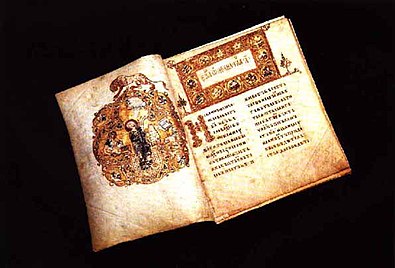


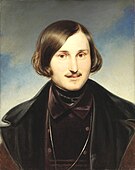






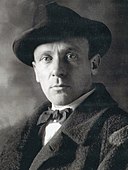













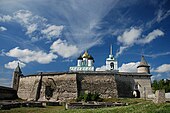
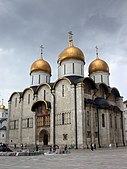

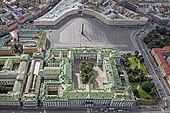

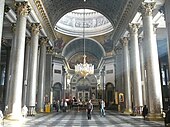




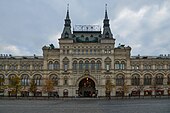













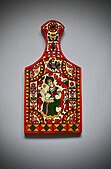

![Russian clothing, ca. 17th–19th century. Metropolitan Museum of Art.[77]](https://upload.wikimedia.org/wikipedia/commons/thumb/1/1f/Ensemble_-_MET_2009.300.3000a%E2%80%93e.jpg/119px-Ensemble_-_MET_2009.300.3000a%E2%80%93e.jpg)
![Russian clothing, late 18th–19th century. Metropolitan Museum of Art.[78]](https://upload.wikimedia.org/wikipedia/commons/thumb/7/7c/Ensemble_-_MET_2009.300.2999a%E2%80%93c.jpg/128px-Ensemble_-_MET_2009.300.2999a%E2%80%93c.jpg)


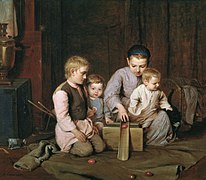





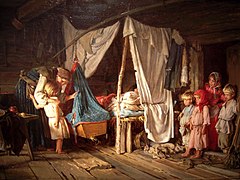
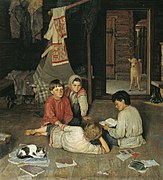
![Court robe, Russian, ca. 1900. Metropolitan Museum of Art.[79]](https://upload.wikimedia.org/wikipedia/commons/thumb/3/30/Court_robe_-_MET_1977.398a%E2%80%93c.jpg/120px-Court_robe_-_MET_1977.398a%E2%80%93c.jpg)







